November 14, 2006
Regine Debatty's

Interview with Lalya Gaye
I've been writing about Lalya Gaye's work over and over again ever since i started to blog. She's one of those few people who seem to swim effortlessly in both the artistic and the purely scientific waters.
She's an engineer and PhD graduate working in multidisciplinary projects that search to explore new territories of personal expression and creativity enabled by ubiquitous computing. Her research focuses on mobile media for urban space and on computational repurposing of everyday objects. In 2002, she started working on various research projects at Future Applications Lab, Viktoria Institute in Göteborg, Sweden. But she still manages to find some time to develop smaller new media projects with friends and to get involved in the mobile music and New Interfaces for Musical Expression (NIME) communities... More >>
Posted by jo at 09:19 AM | Comments (0)
May 25, 2006
Mawhrin-Skel
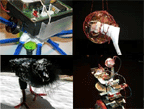
Autonomous Robots
Mawhrin-Skel--by Deanne Achong, Kate Armstrong, Joelle Ciona, David Floren, and Matt Smith, with help from Dina González Mascaró--brings together an eclectic group of local Vancouver artists, who work variously in new media, electronics, sculpture, installation and performance, to create autonmous robots that communicate with one another wirelessly via the internet.
The project--Sheryl [Crowbot] (DA), The Problem of Other Minds (KA), TangleBot (JC), Phono, Mono, and ChartBot (DF), RadBot (MS)--is based on a fictional character--"Mawhrin-Skel"--an intelligent drone that, having failed to meet the conditions of its original purpose, is decommissioned and left to wander aimlessly through a near utopian environment where it becomes a social nuisance and prankster. This character - invented by Ian M Banks in his 1989 novel "The Player of Games" - provides an interesting social and cultural entry point into the study of robots as both cultural artifacts and autonomous members of society.
Robots typically have industrial applications - wireless mines that can dig their way out of the earth and move to a "better" location, machines that cleanup radioactive waste or other hazardous material, surveillance equipment, toasters, coffee makers, etc. It is unusual to build a robot that doesn't have an overt industrial purpose - it may be decorative, dysfunctional, nailed to a tree and bleeping. It exists purely to raise questions about industrial and technological philosophies and ethics in our society. This project examines ideas of function, autonomy, artificial intelligence and purpose-driven technology.
These objects are intended to sit on window sills, desk corners, over doorways, nailed to a post on the back deck, in the gravel pit in the basement, etc. The wireless Internet connection allows the devices to talk to each other and mingle their conversations on the web. The "eyes" of one machine can influence the actions of another. Keywords can generate furious activity or silence. Following the series of workshops, the results of the artists' experiments with robots will be exhibited to the public through a number of events in May 2006 and January 2007.
The Mawhrin-Skel robots communicate with each other using the Scrambler - a message server that was developed in 2003 to connect electronic installation works around the world.
Posted by jo at 10:44 AM | Comments (0)
April 27, 2006
(A)Bugs
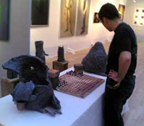
Ceramic Sculpture meets Bluetooth Hacking
(A)Bugs is an interactive ceramic sculpture --at a time when working with ceramics is regarded as "totally lame, not hype at all you know!"-- but also an ironic game on dogmas.
The piece uses the Bluetooth capabilities of visitors' mobile phones to adress them individually as they wander around the exhibition space by using or perusing their electronic identity, and getting their attention towards what has now become a common practice - invisible surveillance. Surveillance has been a major theme of the XLRMX.ORG collective (ChaosCam is an amusing proof of that) which will be present there. The sculpture actually "talks" to the viewer with speech synthesis, engaging him/her in subjects depending on what it can gather on the viewer and where s/he is located (reach, away, stays close, etc.)
Refusing to take side, the sculptural work is central to the critique of dogmas.
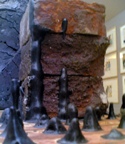
"Obscurantism is not only present in religion and politics with their fundamentalist or totalitarian surveillance dead-ends, it's also something that we have inside ourselves. Playing with these themes is important if one wishes to exercise one's criticism and not fall into the easy 'them vs us' kind of attitude. It's also about admitting we're human and that sometimes, we slip, we make mistakes. That's why a bug is here for. And we can do something about it." said Philippe Langlois commenting his work.
By Philippe Langlois and the XLRMX.ORG collective.
See it at the 51st Contemporary Art Biennale of Montrouge from Thursday, April 27 until Tuesday, May 16th, at the Montrouge theater.
[blogged by Regine on we-make-money-not-art]
Posted by jo at 07:51 AM | Comments (0)
April 23, 2006
PORTA2030
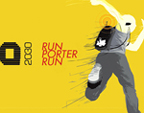
YOU ARE PORTA-PORTER!
April 24 - May 1, 2006 BROADWAY MARKET, London: PORTA2030 is a performative urgency-relay network exercises set within Broadway Market public wifi net-zone. Towards building a portable, sustainable and responsive social network by year 2030, PORTA2030 engages community members as porta-porters for an urgency scenario enactment.
PORTA2030 deploys porta-pack, a mobile network unit that builds on a wifi harddrive (WL-HDD2.5) for multi-faceted transmission. Installed with a 1GB flashcard and programmed in open source codes, the porta-pack functions as a portable data sensing-storage-tranmission unit. A webcam streams images live while an LCD mini-terminal with 4 click action push buttons serve as basic communicative device. The urgency signals triggered by the sensors set in public space further prompt porta-porters' collective action.
Broadway Market (E8, London), known as Market Porters' path for porting produce into the city, is currently under rapid development affected by Hackney Council's regeneration plan. For last two years, physical Porters' Path is implemented with wireless extension provided by the OFF Broadway gallery. PORTA2030 locates Broadway Market as its public performance site with setup of extra access nodes. PORTA2030 updates the porter's path with mobile network porting of communal audio/visual data.
Weeklong performance starts on April 24 with porta-pack dispatch workshop at SPACE media center. During the week, 10 porta-porters engage in networked ommunication. April 29, Broadway market, Porta2030 relay bingo play. May 1, May Day - public screening session with open-air projection: Porta-porters' week and Broadway market related documentaries. For further information please contact now[at]take2030.net
Posted by jo at 01:09 PM | Comments (0)
April 20, 2006
Petko Dourmana
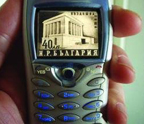
BT_GRAFFITI | Mausoleum_3
The interactive work--by Petko Dourmana--proposes to virtually rebuild the lost physical space of the Mausoleum of Georgi Dimitrov, that used to be the most remarkable public symbol during the Communistic period in Bulgaria, inside the visual and physical space of the entrance at 15 Nassau, New York.
Using Bluetooth technology, visitors are automatically invited to activate it and will receive a series of visual and audio fragments which recreate the space of the former Mausoleum. This newly common-used technology is highly open for communication and in this sense it can be likened to graffiti.
As graffiti in public space confronts passers-by with intentional messages, this work addresses notions of presentation space vs. private space and representations of time and space visually and virtually. [blogged by Emily on Textually]
BT_graffiti project is sponsored by CEC ArtsLink. Produced by InterSpace in association with the Harvestworks Benders and Coders concert series and the 2006 Bent Festival. Presented at 15 Nassau Street in New York City, a venue of the Lower Manhattan Cultural Council. Space donated by Silverstein properties.
Posted by jo at 08:00 AM | Comments (0)
March 07, 2006
Personal Area Networks:
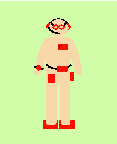
Near-Field Intrabody Communication
"As electronic devices become smaller, lower in power requirements, and less expensive, we have begun to adorn our bodies with personal information and communication appliances. Such devices include cellular phones, Personal Digital Assistants (PDAS), pocket video games, and pagers. Currently there is no method for these devices to share data. networking these devices can reduce functional i/o redundancies and allow new conveniences and services. The concept of Personal Area Networks (PANS) is presented to demonstrate how electronic devices on and near the human body can exchange digital information by capacitively coupling picoamp currents through the body. A low-frequency carrier (less than 1 megahertz) is used so no energy is propagated, minimizing remote eavesdropping and interference by neighboring pans. A prototype pan system allows users to exchange electronic business cards by shaking hands." Personal Area Networks: Near-field intrabody communication by T. G. Zimmerman
Posted by jo at 12:13 PM | Comments (0)
January 31, 2006
SMS Sugar Man

First Feature Film Shot Entirely on Cellphone Cameras
"...They’ve been shooting for over a week now, mostly nights. Everyone’s dead tired, so this particular scene is taking a bit longer than usual to get in the bag. “Action!” says the director for at least the 20th time in as many minutes, prompting the two female leads to start doing their thing at the pool table. As the girls hit the balls, chat and flirt, their movements are recorded by the cameras embedded in two of Sony Ericsson’s slick new W900i cellphones. That’s right: once this film, SMS Sugar Man (by Aryn Kaganof), is completed, it will be the first feature film in the world to be shot entirely on cellphone cameras...
...SMS Sugar Man is emblematic of what anthropologists refer to as the "leapfrog effect". This is when people in developing nations adopt new technology and use it in ways that allow them to overtake users in developed nations. To extract maximum value from leapfrogging, however, you must be an early adopter.
The ways in which people consume entertainment media are undergoing rapid changes...South Africa...is hungry for new content...The future is right here, right now." From Phoning it in by Ryan Fortune, sundaytimes.co.za (via)
Posted by jo at 11:18 AM | Comments (0)
November 23, 2005
TechnoLust

Zones Light Up via Electronic Caresses
Interesting concept of wearable gaming device. TechnoLust blends technological lust with a program to reawaken carnal lust. The gaming device takes advantage of wireless Internet technology. Players wear it as an undergarment to travel out of the virtual world of the computer to find and play with opponents
TecnoLust is a game of body erotic zones that are lit up by electric caresses. Upon entering the game players select the mode they want to play within, this sends out a frequency which attracts other players set on the same game and frequency. When a participant encounters another a game of electronic caresses begins where pulses are sent back and forth electronically to arouse the senses. Designed in 2002 by Peter Allen and Carla Murray, KnoWear. [blogged by Regine on we-make-money-not]
Posted by jo at 06:51 PM | Comments (0)
November 17, 2005
Urban Eyes at V2_
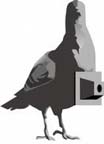
Pigeons as Chaotic Agents and Messengers
On Thursday 24 November, Marcus Kirsch and Jussi Ängeslevä will present their award winning cross-media project Urban Eyes at V2_. Urban Eyes wants to provide an alternative view on the city by using pigeons as the messengers of camera and other imagery overlooking the main streets and back alleys.
Location: V2_, Eendrachtsstraat 10, Rotterdam (tram 4 or 5 / metro Calandlijn, Eendrachtsplein station); Date: Thursday 24 November 2005, 19:30 hrs; Entrance: free; Participants: Marcus Kirsch (UK) and Jussi Ängeslevä (D). Urban Eyes is made possible with support of: Datamars S.A., Sokymat, Motz-Computer, Arts Council England and V2_Lab.
The urban rock dove (columba livia) is part of every cityscape. More hated than loved due to malnourishment based on fast food left-overs, the "flying rat" is very likely here to stay in our urban scenario. The urban pigeon population can be seen as an indicator of the city's atmosphere. Bottomline is, just as every other behaviour pattern and network in the city, we are connected to it as we share the same space.
In a mixture of revived shamanism and panoptic view that might challenge the artificial network of CCTV cameras, the pigeon population's unpredictable movement patterns offer a set of eyes that could offer a unique view onto unknown places. Based on the Bavarian Pigeon Corps from 1903, where homing pigeons were equipped with tiny cameras to take aerial shots from behind enemy lines, Urban Eyes uses RFID and wireless technology to turn the once able urban pigeon into a chaotic agent and messenger of visual impressions from the road you never took.
Perceived as a critical design concept and public art installation, Urban Eyes accesses the live network of pigeons to expand what you know about your own city and reclaim the exploring stage of citylife. In 2004 the project proposal of Urban Eyes won 3rd price at Fusedspace, an international competition for innovative applications for new technology in the public domain. [related post]
Posted by jo at 10:39 AM | Comments (0)
November 16, 2005
blubox + fotobox
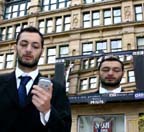
networked public art
"my current research title explores public art as a playful mediated urban environment. to clarify my terminology, I use >playful< to refer to a game-based situation. playing is fun, interactivity can be playful, playfulness mostly experienced by two or more people. i was cautious not to use the word >game-based< or as to describe my art practise as game design. i am however interested in addressing the notion of >game-play<, a term which was mainly used within the context of gaming during the development of video game design in the early 1980’s.
whereas the term >mediated< is not only referring to a space that has been modified such as by the installation of a variety of media tools but also in establishing a mode of >social interaction< that can be generated by such tools. referring to >public art< in the title is aiming to drive forward the debate of >new genre public art<. this development comes out of the more traditional practise of public art, concerning itself not only with the site-specificity of a public place but addresses the significance of audience in the development of the artwork. the emphasis is to widen and define a more >inclusive< mode of public art practice.
my >blubox< artwork is piloting an example of the above mentioned terms and practises and sits amongst 4 other case studies of artists using mobile and wireless media devices. >blubox< which is a systems-based art project, enables the public to network together via bluetooth to play with various designed mobile applications in a coordinated city environment. i am now inclined to change my research title to outline exactly what my art practise is researching: public art as a wireless network." [blogged by Maria N. Stukoff on mobilebox]
Via Locative:
"blubox is a unique bluetooth software and hardware application designed and developed by Maria N. Stukoff and Jon Wetherall for the creative use of mobile phones via bluetooth. as part of this development we are invited to trail the first phase of blubox technology - called fotobox an interactive installation with a public LED screen display - at the 3rd Salford Film Festival in
salford/manchester tonight...
...the next phase of blubox will platform a 3D game environment controlled and played via bluetooth technology. we aim to release the framework for this mobile phone game by march 2006..."
Posted by jo at 08:15 AM | Comments (0)
November 03, 2005
AwareCuffs
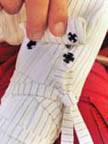
Off the Cuff WiFi Detection
AwareCuffs, the 2nd item of the AwareFashion collection, inform the wearer about wireless hotspots in her environment. Just by glancing at the cuffs, a person can check if wireless LAN is available. Small light patterns that appear on the cloth indicate if wireless LAN is available and the quality of service.
One cuff has an attached pocket and flexible transparent glass fibres are woven into the cloth. The wifi sensing technology is hidden in the small pocket. The circuit board in the pocket displays the quality of service by LEDs in different colors. The LEDs are connected to glass fibres, the light travels through them and small light spots appear at the end. When the technology pocket is detached the cuffs solely consist of cloth and glass fibres and can be washed. This concept also makes it possible to easily replace the technology function of the cuffs.
By Richard Etter and Diana Grathwohl. Other works by Richard Etter: The shirt that senses switched-on mobile phones and Melodious Walkabout. Related: Hotspot Bloom. [blogged by Regine on we-make-money-not]
Posted by jo at 08:45 AM | Comments (0)
September 16, 2005
Wireless London

Addressing Creative Possibilities
In the last five years usage of wireless networks worldwide and in the UK, especially in London, has grown enormously. Community networks, commercial providers and public sector initiatives have been turning to this now-generic technology to provide themselves with local, low-cost networks. As this technology hits the mainstream, expanding the potential scale and utility of these networks, Wireless London addresses the creative possibilities, policies, practicalities and potential of Wireless London.
We see that mobile, pervasive computing will fundamentally change how we work, play and communicate. We want to be able to modify that environment creatively, adapting and customising it as a public space. By researching and developing open systems and tools, and providing models for how these technologies can be deployed, we aim to create a demand for high technical and social standards by raising people's expectations and understanding. See Wireless London: NodelSoftArchitecture...
Posted by jo at 10:44 AM | Comments (0)
September 14, 2005
MOBILE CARTOGRAPHIC COMMAND CENTRE (MC3)

Collaborative Cartography and Unlicensed Wireless Communication
The MC3 is a mobile, educational installation that converges all geo-annotation data being produced by the MDCN’s projects into a single location, visually constructing a continually evolving cartographic model of the MDCN. The MC3 is an outreach project that disseminates the Network's research to the public “on the street” via a large, mobile truck or semi-permanent installation. As well as visualizing the MDCN’s cartographic data, MC3 transfers and repurposes vast databases of digital information from the "expert user" field of GIS to the emerging field of “locative media,” thereby making “inaccessible” data accessible via the Montreal and Banff networks as well as online through the MDCN website. Movie.
Posted by jo at 10:47 AM | Comments (0)
August 29, 2005
A Public Fashion Orchestra
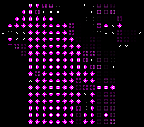
Network Revealed
Temporary networks (ad-hoc wireless networks) are designed to be "visible" to devices only, not to people. Without consulting our devices, we can't tell whether this minute we are participating in a network or not, and we are not asked whether we want to either.
Public Fashion Orchestra--by Alexandra Von Feldmann (with Stuart Wood)-- combines the conservative "wearable" network (e.g. networked wireless enabled mobiles) with an alternative, truly "wearable" and visible network.
The project envisions a fashion house which would sell intelligent clothes and their behaviours. All the clothes are networked with each other and when in range they can share designs and eventually other data; the fashion designer is able to feed new designs and behaviours into the system.
The clothes receive, transmit, transform and show the data, but they can also remember and limit it: once the clothes are "full", they cannot participate in the network anymore unless you get rid of their data with the brush of a hand.
While dressing up, the wearer can activate the clothes. As soon as he/she encounters another fashion network member, communication between the two is triggered by an RFID-Tag embedded into their garments. Once communication is established, data is being transmitted by the devices carried by the users (e.g. wireless enabled mobiles). [blogged by Regine on we-make-money-not]
Posted by jo at 11:56 AM | Comments (0)
August 17, 2005
MATISSE & SMS
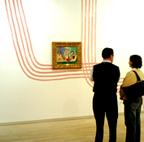
Different takes on Matisse
MATISSE & is the title and framework of an experimental exhibition currently running at the Danish National Gallery (Statens Museum for Kunst) in Copenhagen. Works by three contemporary artists - Malene Landgreen, Jesper Just and Aino Kannisto - are practically and conceptually intervowen with the work of Matisse and visitors can access a sub layer of information via their mobile phones.
More precisely, by sending an SMS to a phonenumber situated next to the individual artworks, visitors recieve a text message - a thought or a statement - formulated by Landgreen, Just or Kannisto. Furthemore, visitors can also submit their own thoughts as well as recieve messages submitted by previous visitors, thus enabling them to interconnect via their feedback. [via guerrilla innovation]
Posted by jo at 05:29 PM | Comments (0)
August 04, 2005
Sending and Receiving
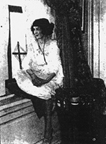
The matrix...net of all nets
"...Indeed, radio — and therefore the beginning of all electronic mass media — is invented by receivers, not by broadcasters. One might modify Duchamp's famous quote that the onlookers make the pictures: "Ce sont les récepteurs, qui font les médias." And even though today it seems as if the broadcasters alone possessed all power over the mass media, there is an almost anarchical criterion, on which all is based and in which the power of the receivers has been preserved: In TV ratings are everything.
How could the power of the receivers be great enough to turn the entire media machine upside down and change it from a strategic into a distributive system? What fascination initiated all that constitutes our present-day electronicized worldview?..." From Sending and Receiving by Dieter Daniels, tout-fait, issue 2. [via]
Posted by jo at 12:06 PM | Comments (0)
August 03, 2005
Pico-Peering

Building the Community Wireless Uber-Network
Imagine a wireless network stretching from Kladno to Buenos Aires; from London to Johannesburg; from Urbana-Champaign to Sydney; to more and more places around the globe. Beginning in 2000, a group of dedicated community wireless developers sat down to figure out a way for a heterogeneous group of Community Wireless Networks to cooperate and affiliate. FreeNetworks.org has led the way — crafting a simple, accessible, 1-page “Pico Peering” agreement that any free network can adopt. I bring this up, not because it’s a new idea (in fact, it’s been pondered, discussed, revised, and refined over multiple years), but because it offers an opportunity for the myriad wireless networks to collaborate. [via MuniWireless]
Posted by jo at 01:02 PM | Comments (0)
August 01, 2005
Flexilis
![]()
Predict the Future by Inventing It
The fellows from Flexilis went for a world record attempt on reading RFID tags from a distance. The end result was a bit over 69 feet on top of the roof of DEFCON. Project details will be in our audio show, for now, a photo gallery of the gear....[via] [Speaking of world records, check out iFiber Redwire, winners of the Wifi Shootout Contest]
Every day new discoveries make it possible for hackers to steal data from mobile devices. You are at risk no matter what you carry. Cellphones. PDAs. Smartphones. All are potentially vulnerable to data theft.
Flexilis, Inc. starts as something simple and stunning: an idea. Through our collective vision and creative nurturing, the idea continues to grow, a concept metamorphosing into reality. The key to revolution is imagination; without it, change is impossible. By employing emerging technologies, flexilis possesses the potential to create entirely new industries or inexorably alter the course of existing ones. In short, we are capable of influencing the movement of technology, and, by extension, society itself.
Flexilis believes in the inherent necessity of taking controlled risks, actively seeking opportunities to create new markets and develop new avenues for implementation. The possibilities are restricted only by the limitations of our imaginations. flexilis will not only respond to the changes in emergent technology, but help to steer its course.
Posted by jo at 09:27 AM | Comments (0)
July 27, 2005
Social Machines

Continuous Computing
"...After a decade of hype about "mobility," personal computing has finally and irreversibly cut its bonds to the desktop and has moved into devices we can carry everywhere. We're using this newly portable computing power to connect with others in ways no one predicted--and we won't be easily parted from our new tools...
There is something different about the latest tools. They are both digital, rooted in the world of electrons and bits, and fundamentally social, built to enable new kinds of interactions among people. Blogging, text messaging, photo sharing, and Web surfing from a smart phone are just the earliest examples. Almost below our mental radar, these technologies are ushering us into a world of what could be called continuous computing--continuous in the usual sense of "uninterrupted," but also in the sense that it's continuous with our lives, in all their messy, social, biographical richness..." From Social Machines by Wade Roush, Technology Review, August 2005.
Posted by jo at 11:01 AM | Comments (0)
July 05, 2005
APCompass
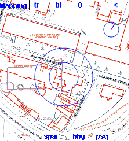
Pioneering and Exploration
APCompass, by David Wiltshire, is the prototype application of the gpsMiddleware platform. It uses GPS technologies integrated with a community maintained database to allow people to explore their local wireless networks. There is an emphasis on pioneering and exploration as users seek out new nodes to extend the database. The project considers issues of privacy, by ensuring every action performed by the user is broadcasted to a central server for anyone to see. Drawing on David Brin's idea of a ‘Transparent Society' APCompass encourages collaboration and accountability as users appreciate the fact that their actions are being constantly monitored.
gpsMiddleware is a custom built C++ application developed explicitly for providing a link between a palmtop computer and a global positioning system. The underlying software is available for download and adaptation for members of the community, so that it can be used as a basis for developing a range of creative applications. [via we-make-money-not]
Posted by jo at 07:49 AM | Comments (0)
June 28, 2005
Yellow Chair Stories

Free Access
With the Yellow Chair Stories, Anab Jain opened her WiFi network to neighbours and passers-by. She placed a sign "advertising" the offer and a yellow chair outside her house, extending the boundaries of her home to encompass the boundaries of my wireless network. Both the sign and the chair defined a "real world blog space" which challenged the idea of "open network".
This "grass roots" design approach illustrates how wireless technologies could become interfaces to recreate transient spaces for conversations at the threshold of the public and the private, the physical and the electronic. Anab and Viktoria Klinker are also showing Sketch-a-move. [blogged by Regine on we-make-money-not]
Posted by jo at 08:14 AM | Comments (0)
June 16, 2005
BUMP_NET - 2005
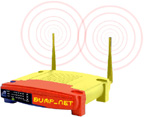
A Wireless Network for the Determined
BumpNet--by Jonah Brucker-Cohen--is a wireless network that challenges the existing methods of connectivity among multiple clients to one wireless base station. The project consists of a public wireless network that only supports a maximum number of connected clients. When a new person joins the network, the first person on the queue is "bumped" or dissallowed access to the connection and network. Like its predecessor: BumpList (an email community built around the same principles), the focus of the project is to determine if by attaching simple rules to communication infrastructures, the method and manner of connectivity and behaviors of people connecting will change over time.
Posted by jo at 10:33 AM | Comments (0)
June 09, 2005
Decoy

Where Data Lives
Decoy is a wireless data project in public space based on bluetooth. Data might be accessible almost everywhere via internet, but it is actually saved or "living" at a particular geographical position. Just the last node of a network remains comprehensible to the user: the LAN-wall-outlet, a modem, a mobile phone, etc. In addition to cables there is a dense wireless network over todays settled areas. Overlapping data-bubbles as big as their radius of range.
The aim of decoy is to pinpoint certain spots in this invisible data space. and these spots themselves are referencing the "real" space. To do so, small bluetooth-servers with a radio range of about 10 meters are placed in public space. These servers are communicating with passing by bluetooth-enabled-devices (e.g. mobile phones, PDAs or laptops). If the owner of these passing-by-devices wants so, he or she will receive a picture. In this aspect a Decoy is something like an invisible poster, graffiti or a direction sign which gets alive by the mobile in the pocket. [via neural.it]
Posted by jo at 09:34 AM | Comments (0)
May 18, 2005
Technojewelry
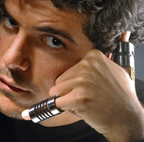
Let Your Fingers and Toes Do the Talking
Technojewelry incorporates emerging electronics into everyday attire. Focusing on the hands and feet as nonintrusive locations for useful innovations, these concepts prove that new devices needn’t look alien to your person and that we can make technology adapt to our lifestyles rather that the other way around.
Penta Phone and Ring Phone are concepts for mobile phones. The design takes its cue from the universal gesture for using a telephone, but is feasibly grounded in the nanotechnology research emerging from start-ups and established companies. Calls can be initiated by raising the hand to the proper position, and voice-activated interaction will allow instant communication. The little-finger units will vibrate to indicate incoming calls and the thumb unit will beam the sound towards the ear when the hand is held in the listening position.
Using similar low-power, nano-derived technology, GPS Toes are toe rings that communicate to a GPS receiver kept in a purse or worn on a belt. Wearing one on each foot, the GPS Toes device will guide the wearer to a preset destination by vibrating and lighting up to signal upcoming direction changes. The left toe ring will indicate left turns and the right toe right turns, whether driving on the highway, walking on city streets, or hiking on the mountain trail.
Also read The Experience of Enchantment in Human-Computer Interaction by John McCarthy et al. [via pasta and vinegar]
Posted by jo at 10:37 AM | Comments (0)
May 03, 2005
Mobile Bristol - Active Posters

Point and Scan
The Mobile Bristol Centre is part of the DTI’s City & Buildings Research Centre: "The purpose of Mobile Bristol is to provide an experimental test-bed for technology and user value research in pervasive mobile media. The vision of the test-bed is to provide a digital canvas over the city onto which rich situated digital experiences can be painted and new commercial ventures can be explored. As you walk through the city a diverse range of digital media experiences such as soundscapes, games, interactive media and art bring the city alive and augment the ambiance of the physical places."
Active Posters is part of the project in 2005: "Active posters are standard printed advertising posters that would be found on hoardings, at bus stops, outside cinemas or the Underground. Unlike standard posters, they have special "barcodes" printed on them. These are read using standard camera phones and link the poster to online content, applications and services." [blogged by Jon on Diablog]
Posted by jo at 09:37 AM | Comments (0)
April 25, 2005
Location33
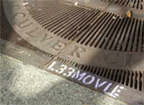
Envisioning Post iPodalyptic Mobile Music
Location33 investigates the potential for new types of music made possible by location tracking and wireless technologies. Listeners, with a GPS enabled PDA or mobile phone, walk around downtown Culver City, California and create a musical album that merges the traditional model of the song cycle with interactive narrative, location awareness, and game play.
Twenty nodes throughout the Culver City area act as portals into the world of the album. Each node is linked with a fragment of a song and when a player approaches one of the portals the music file is streamed to their device.
Each day a specific song is active. It is composed of fragments representing a verse, a chorus, or a bridge. As players walk around, they piece together the fragments, and develop the sense of their path being a song. Each day yields a different song, and all of the components for each day are composed within the limits of a singular musical idea or theme. The album is generated over the course of the week.
The album also focuses on a particular story element, which is sung by one of the characters, Mack, Mackbot, or the Narrator. It is up to the player to discover these musical story fragments and piece them together to form a cohesive story. In particular, the Narrator’s purpose is to contextualize the album within the setting of Culver City and to help the player with hints and instructions.
Location33 also adds elements of game play, asking the player to move around the space to find story fragments in a type of musical and narrative scavenger hunt.
Besides, players can alter the temporal structure of the album, performing time travel operations to experience the album without having to be in Culver City on each day of the week.
Location33 is the thesis project of William Carter, student in Interactive Media at the USC School of cinema and TV.
Read the PDF and doc presentations to see how it works. [blogged by Regine on near near future]
Posted by jo at 12:17 PM | Comments (0)
April 15, 2005
Urban Eyes
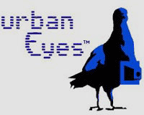
A Bird's Eyeview Experience to the Urban Public
Urban Eyes--by Martin Buschle, Marcus Kirsch, Jussi Ängeslev--is a service combining 2 natural networks, the CCTV and the pigeon population in a city to provide an alternative view on the city. Similar to shamanistic journey, a bond between human and an animal is created when one feeds the pigeon with Urban Eyes bird seed. When the bird flies about, the seed triggers the CCTV / webcam network in a city based on its proximity to the camera. The images are then sent to the person (his PDA) who fed the bird creating a story about the bird and the city.
Due to the purpose of the camera network, the view one perceives, is quite different from the market orientated, everyday media exposure. Ranging from traffic cameras on the lamp posts to gate cams to back yards and living rooms. The experience is essentially about being connected to the bird, the way it experiences the common living circles. Hence acquiring the data, the images and videos directly from the net would be utterly different experience, lacking the physical connection to one's environment and its inhabitants." [blogged by Martin Rieser on Mobile Audience]
Posted by jo at 09:40 AM | Comments (0)
April 08, 2005
Mobile Digital Commons Network Symposium
![]()
Sampling the Spectrum: The Politics, Practices and Poetics of Mobile Technologies
Hosted by the Mobile Digital Commons Network (MDCN), this symposium--May 5th-8th, 2005, Montréal, Canada--examines the impact of mobile culture and the evolving idea of a wireless commons. Over the course of four days, we will investigate how wireless technologies enrich and modify public life in Canada, challenge our notions of space and place, and shape our day-to-day experiences.
Leading researchers, scholars and artists from around the world have been invited to present their cutting edge work in these fields and contribute to an ongoing discussion on these subjects. This event will also serve as a public unveiling of the projects that constitute the launch of the MDCN.
The MDCN connects those members of the academy, the arts and industry whose work revolves around mobile, wireless, and digital technologies in Canada. Funded by Canadian Heritage, our goals are threefold: to facilitate interdisciplinary research; to foster cultural production and public participation; and to develop forward-thinking policy on wireless technologies.
Posted by jo at 02:26 PM | Comments (0)
Pervasive Connections
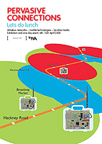
Lets Do Lunch
PERVASIVE CONNECTIONS/LETS DO LUNCH A one day event and exhibition focusing on opportunities for artists and local communities to work with new social technologies.
TAKE2030 takes its richair wireless lunchboxes out to lunch in Hackney and brings the conversations back to Space. Let's Do Lunch tracks Hackney's public access wireless connection points along bus route 26. Lunch dates will be set up with community members to exchange practical skills and visions for a wireless Hackney. The exhibition at SPACE will include a map of Hackney's wireless outposts along bus route 26, documentation of 7 lunch dates and auto transmitting wireless lunch boxes. Pump the signals, realise a wireless Hackney.
Pervasive Connections/Lets Do Lunch
Wireless Networks - Mobile Technologies – Locative Media Event
Saturday 16th April 10.30 – 5pm
Exhibition 6th – 16th April (Weds – Sat 1 TO 6pm)
SPACE, The Triangle, 129–131 Mare Street, London E8 3RH
£5 (includes lunch) booking required
Talks:
Introduction to Wifi - Saul Albert from Wireless London
Artist talk by TAKE 2030 linking to the exhibition Lets Do Lunch.
Workshops:
Network self provision– James Stevens Making flowers with palm top devices – Peter Chauncy Film for mobile phones – Melissa Bliss and Jes Benstock Public authoring and sharing local knowledge – Giles Lane
Panel discussion:
Featuring artists, activists and media practitioners, including James Stevens, Peter Chauncy, Graham Harwood, Matsuko Yokokoji, Rokeby, TAKE 2030, Indri Tulusun. Chaired by Pete Gomes – Wireless London
Let’s Do Lunch - 6 April – 16 April 2005. (Wed – Sat, 1-6pm)
Pervasive Connections/Lets Do Lunch is organised by Space and inIVA as part of Discover Hackney.
Booking To book a place on the one day event ‘Pervasive Connections’, please contact SPACE Media Arts on 020 8525 4344 or spacemedia@spacestudios.org.uk
Further information
http://www.spacemedia.org.uk
http://www.spacestudios.org.uk
http://www.iniva.org /
Directions
Bus: 26 & 48 from Liverpool Street, 106 & 254 from Bethnal Green, 55 from Old Street.
Tube: Bethnal Green.
Train: Hackney Central Silverlink.
Posted by jo at 09:19 AM | Comments (0)
April 04, 2005
TAXI MADRID
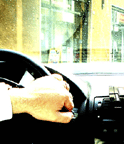
Another Taxi Installation
TAXI MADRID is a mobile public art intervention by artists Anne Lorenz & Rebekka Reich addressing issues of perception and the logic of memory. Equipped with installations, 12 taxis will operate in Madrid throughout the duration of Madrid Abierto, transporting their passengers into someone else's mind and memories of Madrid, those of an ex-patriot.
By interviewing former inhabitants of Madrid, who now live spread all over the world, artists Anne Lorenz and Rebekka Reich seek to find intriguing personal memories related to the city. From this material they devised sound-collages to become part of more complex installations, consisting of objects and other memorabilia, fitted into the taxis.
Regular taxi-users are caught off guard in the confined space of a car, abducted for a short amount of time from their everyday business. The artists seek to surprise and entertain the passenger by confronting him or her with an insight into the memory of a stranger, provoking a memory lapse. Due to the geographical distance of the interviewees an overlay of two pictures occurs: The out of date view of the ex-patriot merges with the current situation on site, and the meeting of the two lives on in the memory of the passenger.
To experience TAXI MADRID call Teletaxi: 91 371 21 31 / 902 501 130 and ask for a taxi from MADRID ABIERTO. Conditions are the same as usual.
Posted by jo at 09:15 AM | Comments (0)
March 30, 2005
GPS-Art
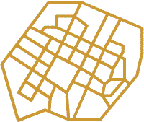
GPS-Trans Net-Cellphone Performances
GPS-Art is a new field of art activity based on motion in open spaces. GPS-Art is the global interactive instrument used for the creation and processing of audio and video material. It integrates elements of audio-visual installation to be used as a new media transmission. The project is based on large outdoor scales of cities and open spaces; it is ready to be realized on land, air, underwater as well as in outer space.
All GPS-Art projects use the GPS-12 device (Global Positioning System), as well as the cell phone system. GPS-12 refers to the 12 satellites hanging above the Northern half of the globe; it's used for navigation and measures in an interactive way many topographic parameters including latitude and speed. These measurments are the starting point of many art projects of GPS-Art. Since 2001 GPS-Art has been realized by a series of GPS-Trans net-cellphone performances.
Posted by jo at 05:13 PM | Comments (0)
March 29, 2005
The Royal Society of Emotional Geocachers
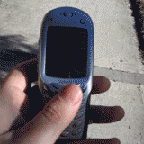
Place is Story>>Character Equals Space
Navigate a hypertext journey of sound, image and video where stories and characters intersect over time and across the city geography as one link leads you on foot to another. Available via GPRS on your mobile phone, or download from the internet on to your PDA (such as a Palm Pilot).
"This site exists for members of the society to document key personal experiences at specific locations. Please join us and add your own story of place. We've designed this site specifically for mobile devices so members may read & comment upon other members experiences in situ. The Rules; be true, place is story, character equals space, every story must connect to another story. Every tale must contain gps co-ordinates, maps and directions."
Posted by jo at 02:30 PM | Comments (0)
March 25, 2005
Pervasive Game Development Today
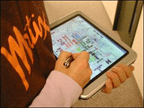
24/7 Immersion
"...Pervasive gaming was first the vision of Swedish company It's Alive!, meaning location-based games that surround you, 24 hours a day, everywhere. When you walk down the street, you're walking through an adventure world draped on top of the real world, and people you meet may be characters in the same game you're playing. Pervasive games are built upon three core technologies: mobile devices, wireless communication, and sensing technologies that capture players’ contexts. It is actually the blend of technologies combined with the location-based and often public nature of game play, gives pervasive games their distinctive identity [Bridging the Physical and Digital in Pervasive Gaming]." From Pervasive Game Development Today by Fabien Girardin.
Posted by jo at 02:10 PM | Comments (0)
March 24, 2005
Blast Theory presents Can You See Me Now?
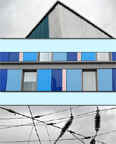
Join the Hunt
Played online and in the streets, BAFTA-nominated Blast Theory challenge you to a game of cat and mouse around a virtual map of Cambridge. Log on using the public terminals situated in the Junction's new café bar or play online at canyouseemenow and be dropped in at a random location from where you must avoid capture by the Blast Theory 'runners'.
Eavesdrop on your pursuers' conversations and swap tactics with other players as Blast Theory (as real actors positioned on the real streets of Cambridge) hunt down your virtual presence with the aid of handheld computers and GPS technology. FREE to play. April 1st-3rd 2-5pm; April 6th-8th April 4-7pm at The Junction, Cambridge.
Artists' Workshop: April 6th 1-4pm; £5/£4 concessions
The player is a key feature in all Blast Theory's work. This afternoon workshop will look at how the audience engages directly with an artwork, in dialogue with other 'players' and the artists.
Using the player as a focus, participants will respond creatively to site/space, game structure and forms of media/communication technologies to inform and stimulate their own media and performance practice. Finally all participants are welcome behind the scenes at 4pm to look at the hardware, software and performance preparation of 'Can You See Me Now?' Blast Theory's award-winning interactive game, presented by the Junction.
Suitable for artists looking to expand their understanding on new performance technologies, participants should come prepared to move, draw and talk.
To book a place call the Junction box office on 01223 511511 or visit in person at The Junction, 2 Clifton Way, Cambridge, CB1 7GX. [via DAN]
Posted by jo at 11:42 AM | Comments (0)
March 23, 2005
Honey, I Geotagged the Kids

How collaborative cartography could enable us...
"...Whether it's wearable computing that tracks our locations no matter what we happen to be doing, cell phones that let us enter our locations, moods or other data, or even all the wireless nodes, satellites and grid networks capable of finding, resolving and comparing all this information, we're talking about an entirely wireless phenomenon. We're also talking about what might prove to the be ultimate legacy of all our hard work here in the wireless trenches: locative media.
The phrase itself was originally coined by Karlis Kalnins, of gpster.net, who applies the precise logic of linguistics to an otherwise seemingly vague field. "Locative is a case, not a place," Kalnins says, meaning it stands for a final location of an action or the time of the action. In other words, it doesn't just happen in space, like a map, but also in time..." From Honey, I Geotagged the Kids by Douglas Rushkoff, theFeature.
Posted by jo at 10:22 AM | Comments (1)
March 03, 2005
Receiver #12

Seamless Mobility?
Receiver 12 is now available. This issues includes Mobile Movies – Taking Film to the Public Space, by Heinz Hermanns; Beyond Just Getting There – The Interactive Road by Oskar Juhlin; Visions of Culture in the Era of Mobility by Ranjit Makkuni; and The City Shaman Dances with Virtual Wolves – Researching Pervasive Mobile Gaming by Frans Mäyrä.
Posted by jo at 06:22 PM | Comments (0)
CITYSNAPPER_Game
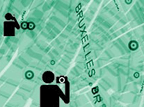
Build A Representation of Brussels
The CITYSNAPPER_Game--by LAb[au] and iMAGE z[ONE]/Olivier Vanderaa--is an urban interactive photographic game in real time, using an online 3D electronic space and SMS server technology, relating the urban space with the World Wide Web, and users (players) with an urban photographer. Players use SMS to instruct the photographer to go to a particular part of town and bring back a picture of it; orientate the shooting with additional verbal instructions (word, sentence, riddle); and record their response. The photographer takes a picture with a cell phone and implements the interface via SMS. The audience can follow the game through the online 3D interface from a home computer or by navigating the 3D model of the city screened in the exhibition space. At the players can retrieve a print of the image "they gave birth to."
Posted by jo at 04:33 PM | Comments (0)
March 02, 2005
YellowArrow at DiVA
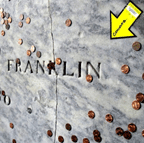
Art in Motion
Digital and Video Art Fair [DiVA] kicks off with an opening after party on March 10th that will definitely be an event in itself. The party will feature special performances by YellowArrow. Attendees are invited to participate in the art in motion. In addition to YellowArrow stickers’ distribution and projections displaying the content of the YellowArrow Global Gallery, mobile YellowArrows will point out a series of live micro performances staged throughout the party and announced via TXT messaging.
DiVA is the first art fair in the United States dedicated exclusively to digital and video art. DiVA will serve as an international destination for collectors, art dealers, museums, curators, and artists. Around forty galleries willfeature the diverse and innovative work of new media artists exploring and pushing the digital envelope. Digitally created work is a dynamic platform of expression in contemporary art that includes film and video, animation, photography, printmaking, sculpture, painting, architecture, and performance.
The YellowArrow is a global public art project that merges graffiti and sticker culture with wireless media, creating an interactive forum for people to leave and discover messages pointing out what counts in their environment.
Participants place arrows to draw attention to different locations and objects -- a favorite view of the city, an odd fire hydrant, the local bar. Each arrow has a unique code, and by sending a text-message (SMS) from your mobile phone to 1.646.270.5537 in the format "+code your message" you associate a short text with your arrow -- messages can range from literary quotations to personal commentaries to game-like prompts to action.
When another person encounters the arrow, he or she sends "code" to 1.646.270.5537 and immediately receives the message associated with it on their mobile phone. Through this location-based exchange of text-messages, the YellowArrow becomes a symbol for the unique characteristics, personal histories, and hidden secrets that live within our everyday spaces. And it's not just places, it's people: YellowArrow TXTshirts are individually coded just like the stickers.
YellowArrow text-messaging is currently compatible with all phones and service providers in the US as well as internationally with those networks under the GSM standard. The website, YellowArrow.org, allows participants to annotate their arrows with photos and maps and is the online gallery of YellowArrows placed throughout the world -- visit to order arrow stickers and tshirts and see announcements about new events and features.
Posted by jo at 11:16 AM | Comments (0)
February 28, 2005
Ad Hoc Information Spaces
Temporary Networks
"Abstract: We describe the concept of ad hoc information spaces as a way of distributing information in an environment depending on user mobility and relative location. Ad hoc information spaces are realized using a decentralized approach to ubiquitous computing, which is based on functionally self-contained devices and ad hoc networking. Users are able to contruct and manipulate the properties of these information spaces by means of moving and manipulating a variety of devices. In order to explore the possibilities of using ad hoc information spaces to support group collaboration, three prototypes were developed: the Hummingbirds, the Generalized Hummingbirds and the NewsPilot. These are described along with some of the empirical findings that support their design." Ad Hoc Information Spaces - Johan Redström, Lars Erik Holmquist, Per Dahlberg and Peter Ljungstrand. [via]
Posted by jo at 10:29 AM | Comments (0)
February 24, 2005
Liveform Telekinetics [LF:TK]
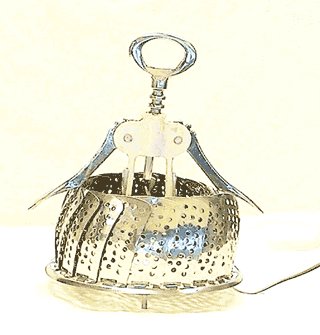
Experiments in Connected Social Spaces
"...Sharing a meal, a walk in the park, weddings, sports, or cafés...are the kind of social activities and rituals we associate with human relationships...What if you could go out for dinner and dancing with friends, even though you're a thousand kilometers away?...(W)ireless Internet "hotspots"...provid(e) the possibility of multi-situated presence, but (are) also placed within a fixed physical location, a social environment rich with familiar objects, rituals and codes of behaviour.
LF:TK takes a playful approach to the ways we might inhabit such a hybrid environment. Furniture, decorations, cutlery, bric-a-brac and cultural debris are reconstructed as networked interfaces that populate surfaces within everyday social spaces. Each object provides a simple function, yet when combined with others helps build a complex arrangement of movement and gesture. Imagine a shared creation, a social ritual, a dance through objects, a table that is played." [Recipe for Corkscrew Man]
Posted by jo at 05:34 PM | Comments (0)
February 21, 2005
Girl Friday

A Mobile Interactive Drama Series
Glued to your mobile phone? SMS crazy? Got no time for TV but love a good drama? Girl Friday (GF) is here and it's sure to be as addictive as your phone and that soapie that you can't miss. Girl Friday's life changes when she finds a mobile phone on a tram on the way to work. She soon becomes engaged in the mysterious life of the stranger's phone. All the while she has paper clip trouble at the office; is searching for the mother she never knew, and is clawing her way to the top of the local karaoke charts.
GF beams straight to your mobile. No wires, no cords, no lengthy downloads. It's entertainment on the run - small digestible bites of life for viewers to consume at will. For the content hungry, there's a website too. Whether you can take the chunky stuff on a broadband connection or the low fat version on your 56K modem, you won't miss out on the daily sagas of Girl Friday. [via Cross-Media Storytelling]
GF will be Australia's and possibly the world's first mobile cam girl. She is a live action character who on the surface appears 'real' but in fact is a fictional part of the GF interactive world. Her story reflects the way devices (such as your mobile) are changing the way we communicate in everyday life. As GF tries to deal with the sagas of career, love and family we journey with her as a friend and confidant.
GF is a sophisticated interactive drama with a comic edge; taking its lead from outstanding programs such as Sex In The City and Ally McBeal. The program will delve into some of life's sticker questions with insight and humour, and aim to satisfy the content hungry 16-30 year old market.
Once you start, you'll be hooked and aching for your weekly GF fix.
Posted by jo at 10:52 AM | Comments (0)
February 20, 2005
digital cities project
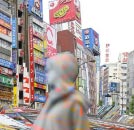
urban database as feedback loop
The Digital Cities Project is a collaboration between several Canadian research insititutions exploring digital technologies inthe urban environment. As part of the Mobile Digital Commons Network they presented at the Pervasive and Locative Arts Network [PLAN] workshop at the ICA in London on February 01-02.
The project research basis: Over the past two decades, several nations have embarked on a “digital” strategy to become key players in the new information economy. Interestingly, despite the heralded innovations these technologies promise, most nations have pursued a similar use of space and place to build isolated multimedia cities. Our research project investigates and analyzes four such multimedia initiatives beginning with the Cité Multimédia and Technoparc in Montreal. This project investigates traces of the “digital city” and its networks, from multimedia districts to virtual environments and mobile devices. The role of technology in the city has been an important focus of cultural research.
While earlier studies have concentrated on urban infrastructure such as electrification and transportation routes, new communications media have given rise to technological systems and networks that re-order the city. Through the workings of new communications media, the social and technological apparatus of cities is transformed, altering the terms of urban theory and representation.
This type of feedback loop not only expands the site of the "interface" from computer terminal to the city, but also multiplies types of input to encompass both physical and virtual data. Our research asks what would happen if the feedback loop were inverted, such that the city controlled the data, and the data's performance were always measured against the changing tides of urban life. Such a circular interplay challenges the discrete status of data, and instead requires a process of continual re-situating and adjustment within urban context. In this sense, we are reversing the logic of the feedback loop, which attempts to maintain system equilibrium in the face of disturbance. By privileging urban dynamics as the "command signal" that guides the data, the database becomes doubly urban, both documenting and being shaped by activities in the urban environment to form an expanded feedback loop.
Posted by michelle at 11:56 PM | Comments (0)
February 14, 2005
Teaching for the Wireless Commons
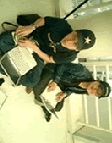
Interview with Elizabeth Goodman
[As part of WebCamTalk1.0]: Trebor Scholz: Please present your thoughts on new media education, in particular your course "Site-Specific: Wireless Networks and Urban Art Practice."
EG: This course was a mixed graduate-undergraduate seminar I taught at the San Francisco Art Institute with Alison Sant. The course examined radio signal as a medium for expression in its own right, with its own aesthetic qualities and cultural significance. It was a diverse class, with undergraduate and graduate students. The class focused specifically on sensing and representing wireless signals; we did not intend it as a technical class centered around any one tool. Using whatever medium they preferred, students were to create their own interventions into what Fiona Raby and Tony Dunne have called the "Hertzian space" of San Francisco. Final projects included a game, a proposal for a video installation, and a GPS-coordinated city tour. There have only been a few classes on wireless networks as art medium thus far, so there weren't many models to draw from.
TS: What did you learn from the experience of teaching a course with so little precedence?
EG: Learning from the experience of this course and from my own experience in school, I'd like to point to some larger issues about the state of interactive art education:
1) Art education: training for what?
2) The importance of historical perspective
3) Defining core curriculum
4) Moving the computing arts away from the computer
TS: Please describe the course more in detail.
EG: The Art Institute in San Francisco, for those of you who might not be familiar with it, is well known for its historical emphasis on conceptual art. Alison and I found that, as so often happens, our students were more comfortable with the conceptual. Partly, this is because it's easier to talk than build. But the greater issue was unfamiliarity with the underlying technologies of wireless networks "the physics of radio waves, the proliferating transceivers, the logging programs and the graphic interfaces" not to mention the pervasive fear of the unfamiliar. Even with the loan of wifi- , Bluetooth-, and GPS-enabled iPaqs from the Exploratorium, some were reluctant to experiment. And those that did were often daunted by the amount of time they had to spend troubleshooting the devices. An increasing number of people comes to courses such as ours with some knowledge of computers, but only few are comfortable with code.
Indeed, some of our students came in with far less knowledge of the tools of new media artists than we had expected. "New media" stretches from video and sound editing, to image manipulation, to animation, to interaction design, and code. The question of documenting and presenting a new media project gets complicated when you've never used a digital camera or created a web page. In addition, students were dismayed by the seemingly endless list of expensive equipment that visiting artists recommended. Laptops, GPS devices, PocketPCs, wifi-cards, specialized radio receivers. Some felt that the medium was simply unaffordable on a student budget, and the school was not planning on picking up the bills.
TS: This is a phenomenon that you also find with much of recent location-based cultural practices that require a whole set of hardware that it still unaffordable to most city dwellers.
EG: There's an interesting and common phenomenon that happens when students--anyone, really--attempts a new medium. You called it "techno-determinism" and I agree. It's a kind of blindness. The sheer difficulty of making any headway with unfamiliar and imperfect technologies such as PocketPCs running an interface to a Bluetooth GPS module, or a Flash animation, leads to the mistaken belief that the technologies themselves are the most interesting part of a project.
TS: How do you approach the confluence of art, theory and technology?
EG: Given students's understandable fears of new, unfamiliar, and un-user-friendly technologies, we need to actively reward exploration, experimentation, and sheer determination. However, the class as a whole suffers when the focus of discussion and critique moves from developing and expressing concepts to solving technical problems. Steering a course between technophobia and techno-obsession is harder than it sounds. One of the great challenges, I learned, of teaching "new media" classes that are not designed to be technical workshops is keeping promising concepts (that are often technologically interesting as well) from derailing into technological minutia. Throughout the class, Alison and I developed some strategies in response to techno-phobia, techno-obsession, and the sheer expensiveness of electronic equipment.
TS: How do you link these emerging cultural practices to their backgrounds in the history of technology, and culture at large.
EG: There is a tendency among the techno-obsessed to think that "new media" is somehow the product of a catastrophic, unbridgeable break with older tools and practices. Alison and I tried to locate the class within a longer history of site specific art and urban engagement. We started by asking students to think critically about the notion of "site" drawing on Robert Smithson's work, the notion of "non-sites" and on Gordon Matta - Clark's building deconstruction projects. We also used sources from urban theory, the Situationists and asked students to think about how we come to know a city "how we travel through it, how we map it, how we remember it. We found that bridging the old and the new produced richer conversations in new students " which is no surprise but also created a comfort zone for San Francisco Art Institute students who were already familiar with mid-twentieth century art movements.
TS: You mentioned that a few weeks into the class you asked students to switch off their computers and go to the drawing board.
EG: Yes, drawing and sketching also proved a useful introduction to the ideas and methods of the class. One of our most successful class exercises required students to create a map of the campus using only mobile phones, paper, and pencils. Working in teams, students had to both agree on how to represent mobile phone signal strength but also what areas they found most significant. The resulting critiques allowed us to talk about some core issues: the representation of temporality, definitions of site, and visualization of the invisible.
In fact, mobile phones became a cheap and accessible medium for students daunted by the expense or unfamiliarity of wifi-enabled laptops and GPS devices. For those of us who think in terms of code, it can be useful to step back and see mobile phones as a platform for development but also simple sensors in their own right. One student even used his mobile phone as a kind of game wheel, dynamically spinning paths through the city based on signal strength.
I would have loved to have my students build applications for mobile phones. But because the class blended art theory and practice, we had to think realistically about time management. We simply did not have enough time to both introduce key concepts and teach programming. As well, showing a project in a gallery is very different than supporting it on a city-wide level. Moving from the university lab to the streets means asking students to simplify their technical needs as much as possible.
TS: Could you come back to the four main issues that you introduced earlier? You started off with "Art education: training for what?"
EG: One of the subtexts running through in-class discussion was the desire to be taught specific tools, Photoshop or Flash, for example. There is a lot of fear about the high cost of education in North America, about getting jobs, and that is reflected in these demands for vocational training. I think many will agree with me when I say that undergraduate art courses should not focus on software. Defining education by the tools currently in vogue reduces learning to a set of instruction manuals. As we have all discovered, learning is often more a changing set of practices than abstract, static data.
Which brings me to my second point: defining a new media core curriculum. I think student calls for software-based training indicate a deep insecurity. Many students are not sure what they are supposed to know and how they are supposed to learn it. That is a very disconcerting situation. And part of the role of a faculty member is to answer those questions through curriculum development.
A curriculum is or should be the articulation of a community's understanding of disciplinary boundaries: what they value, what they exclude, what they require. I had a fairly traditional undergraduate art education, based around a choice of prerequisite classes: drawing, sculpture, photography, graphic design. Drawing was mandatory. As a master's student at New York University, I had another core curriculum: programming, basic electrical engineering, visual design, and communications. Everything was mandatory. Communications included training in Photoshop, video editing, etc. but it came wrapped in a larger conversation about the social significance of technologies.
I personally believe digital media core curricula should include programming and drawing. But I'm not the deciding factor in discipline-wide curriculum development. The faculty of every school has the responsibility to decide what their students should learn. I don't think we'd see wildly divergent curricula. But internal conversations need to happen so that consensus can emerge and students get consistent messages about what they need to succeed.
TS: An additional starting point was your emphasis of moving the computing arts away from the computer. Please elaborate.
EG: To me, this is perhaps the most important point: moving the computing arts away from the computer. One of our greatest struggles during the class was the fixation on the technical at the expense of the conceptual. We suggested refocusing projects, but more than once we found that students did not believe that sketching counted as part of their work as digital artists. Yet in retrospect, it's significant that the semester's most successful exercise was based on drawing.
For us, the lesson was that teaching the digital arts should not be confined to digital media. Many institutions without the budget for expensive equipment can use diagrams and formal logic as a proxy for circuitry. Nothing can totally replace learning by doing, but teaching the underlying principles of computing still helps students. As Casey Reas points out, code creates the tools we use; it's an important medium in itself. I think that teaching drawing can serve as an important bulwark against the fixation on technology, and it can remind students to focus on the underlying ideas that they strive to communicate.
So, I see several issues: I feel conflicted about the perception of the teaching of "new media" as something that is completely new. Another issue is thinking solely of what we produce as solely a function of media. I think we'll do ourselves and our students a service if we think less about newness, less about a specific media, and more about continuing art practices based around the implications of computing.
About:
Elizabeth Goodman's design, writing, and research focuses on critical thinking and creative exploration at the intersections of new digital technologies, social life and urban spaces. She has a master's degree from New York University's Interactive Telecommunications Program and has spent this fall as a visiting lecturer on site specific art and wireless networks at the San Francisco Art Institute. For a course bibliography visit www.molodiez.org/biblio_goodman.pdf. More examples of Elizabeth's work in urban gaming and cellphone interfaces can be found at www.confectious.net. [via Rhizome]
Posted by jo at 11:18 AM | Comments (0)
February 10, 2005
Seamful Game
![ubicompclient[1].gif](http://www.turbulence.org/blog/images/ubicompclient[1].gif)
Glitches are Integral
Seamful Game, by Matthew Chalmers from the University of Glasgow (Scotland), is a GPS and WiFi based game played in the streets using PDAs. To be successfull, two teams of runners must develop an understanding of the network coverage and the effect of signal strength. It thus turns the patchy network coverage, usually seen as a problem, into an important feature of the game.
Players travel around a designated area collecting digital "coins" (which appear all over the map, including in places not covered by the 802.11b wireless network) and uploading them to get points. To gain these points, players must upload the coin to the server, by pressing the "upload" button on their PDA in an area where there is 802.11b coverage. If players attempt to upload coins in an area not covered by WiFi, the upload fails and they loose all the coins they are carrying. [blogged by Regine on near near future]
Only by understanding the boundaries of the network, and the effect of signal strength on their ability to upload coins, and thus score points, will players be successful in winning the game.
The "Pick Pocket" feature of the game allows a player to steal coins from other players nearby. The player has to be inside network coverage, and use the GPS to get within 10 meters of another player (also within network coverage). By pressing the "Pick Pocket" button, they can grab any coins the victim is carrying but has not uploaded yet.
Plus, scattered around the map are "Mines". If a player moves to within 10 meters of a mine, it will detonate and the player's PDA will be temporarily disabled.
Posted by jo at 09:36 AM | Comments (0)
February 09, 2005
PacMan Must Die
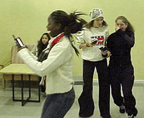
Collaborate or Lose
Students at the Future Applications Lab in Göteborg, Sweden have developed PacMan Must Die, an innovative video game with a playing field distributed across mobile wi-fi-enabled devices belonging to all the players. The game combines dynamics of play in physical places with the world of video games in a new way. To win, players have to cooperate with one another physically. [originally blogged by Sean on Cheesebikini?; reblogged by Sean on Smartmobs.]
Posted by jo at 11:18 AM | Comments (0)
January 22, 2005
Project Molly

Light Lunch with Molly
"Project Molly is a series of roaming interactive webcasts captured live using a wearable wireless audio/video acquisition system by artist Nichola Feldman-Kiss. Please interact with Project Molly live for light lunch and conversation via internet relay chat at the Project Molly interface."
Project Molly was a performance art/research innovation; it used a Xybernaut wearable computer with a head-mounted audio video acquisition and display system to stream a live video feed to the internet via wireless connection. The prototype real net video performances interactively linked the remote audience with the real time audience/performers via Project Molly’s personal a/v surveillance and chat interaction. Each consecutive interactive webcast incrementally evolved the project molly interface and knowledge database. Ultimately, the interface tracked project molly's movement through real space and captured streamed video into a data archive that is indexed and searchable by a variety of terms.
Posted by jo at 12:16 PM | Comments (0)
January 19, 2005
Location is Everything

Rhizome.org ArtBase Exhibition
Location is Everything--curated by Jillian Mcdonald--explores ways in which artists repurpose mapping as a creative medium; or perhaps it reframes mapping as a procedure that is intrinsically creative. The cartographic forms in these projects are drawn according to, as Mcdonald explains, personal or collective experiences, some informed by external factors like weather data or pop-culture references, and some allowing the map itself or local residents to inform them. These reciprocal actions of forming and informing effect both maps and their makers, suggesting that who? and why? are equally important questions to pose when interpreting a map as simply where?.
Works included in this exhibition are "PdPa" (2003) by Julian Bleecker, Scott Paterson and Marina Zurkow, "[murmur]" (2003) by Shawn Micallef, "Louisiana Walk #14" (1996) by Janet Cardiff, "Atmospherics/Weather Works" (2003) by Andrea Polli, "GPS Drawing" (2000) by Jeremy Wood, "Hlemmur in C" (2004) by Pall Thayer, "Survey Field" (2003) by Germaine Koh, and "Infrasonic Soundscape" (2001) by Hidekazu Minami.
Posted by jo at 12:03 PM | Comments (0)
January 17, 2005
Grafedia
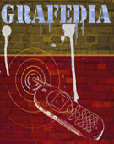
GraffiTML
Keyboards often eclipse pens as the writing tool of necessity. As computers continue to gain precedence in our lives, we fill a graveyard with lost penmanships and John Hancocks of decreasing legibility. John Geraci combines the personal imprint of handwriting with the connective possibilities of the Internet in his newly released project Grafedia, developed at NYU's Interactive Telecommunications Program. Elaborating on themes explored in neighbornode--a wireless, localized bulletin network Geraci built in 2004--Grafedia turns the city of New York into a potential webpage. An author can write, draw, even tattoo, a hyperlink onto a public space in the form: my_original_thought@grafedia.net. The author also uploads media corresponding to or enhancing to the location, like an original photograph, to the Grafedia site. Passers who encounter a link can 'click' it by sending a text message to my_original_thought@grafedia.net. In turn, Grafedia beams the author's hidden media back to the inquiring wireless device. Since Grafedia's annotative marks are not anonymous but in fact scrawled by the hands of their authors, viewers are able to follow particular people and stories. And the cherry on top my original photograph? It's a lot fun. - Alyssa Wright, Rhizome's Net Art News.
Posted by jo at 09:38 AM | Comments (0)
January 13, 2005
Surface Patterns: Walking Tours
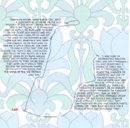
10 People. 10 Walks. 10 Stories Told.
Walking Tours and Audio Tours are two new works by artist Jen Southern commissioned by centrifugalforces and the media centre for Surface Patterns. Both works use a Global Positioning System (GPS) device to explore how memory is linked to urban and domestic places. The GPS device can only describe latitude, longitude and altitude: however, when used to trace the route that someone walks through a place, it can reveal the pattern of the path taken, allowing us to share knowledge of hidden locations and unexpected vantage points along the path.
Traditional maps tell us where landmarks are, what streets are called and where to find the centre of town, whereas the subjective histories and stories explored in this work are played out over time and rely on very different 'memory maps'.
The installation Audio Tours at the media centre uses contributions of unwanted wallpaper, pasted on the gallery wall and threaded or punctuated with GPS patterns of 10 walks. Traces of audio recordings made in conversation with the walkers are manipulated and played back in the gallery, recalling the simple flipping, mirroring and inverting techniques employed in the patterns of the wallpaper. Reflecting different perspectives on the town, the walkers include members of the artists family who grew up in Huddersfield in the 1940s and 50s, as well as a previous Artist in Residence at the Digital Research Unit in The Media Centre who lived in the town for three months. Memories range from the last Sex Pistols gig to architectural history (both public and domestic) and personal freedoms of walking in urban space.
Walking Tours consists of 10 PDFs to download and print, each using a wallpaper pattern, a walked route, and a story about Huddersfield.
Jen Southern is an artist who lives and works in Huddersfield. Her process-based practice investigates everyday journeys between virtual and physical spaces, using socially embedded technologies such as video games and mobile phones. She has been working with global positioning devices for the past two years; recent projects using GPS: Area Code (www.areacode.org.uk) with exhibitions at Magna, The Museum of Science and Industry and Artranspennine 03. Jen's work has been exhibited nationally and internationally in public spaces galleries and festivals.
Posted by jo at 07:53 AM | Comments (0)
December 29, 2004
Wireless Politics

The Future of Digital Democracy
Wireless Politics May Determine Future of Digital Democracy, Part One of a Two-Part Series by Michelle Chen, The NewStandard, December 29, 2004.
"A teenage public housing resident searches the web for scholarship opportunities while her mother looks up tips on starting a small business. A public art space lets visitors download a multimedia exhibition onto their laptops, which are simultaneously linked to a dozen other galleries around the city. A local Independent Media Center breaks news before the major network affiliates by sending a report instantly to thousands of home computers sharing a wireless network.
You may not be able to see into the future of digital democracy, but you may already be breathing it; the new frontier, say activists and technophiles, is on the air. Broadband access and its wireless digital "ether" are giving rise to a new technological geography that defies spatial boundaries and historical precedent." Continue reading >> [via]
Posted by jo at 11:35 AM | Comments (0)
December 27, 2004
netzwissenschaft
![]()
Emerging Infrastructures of All (Inter)net Research
Dr. Reinhold Grether's network research | netzwissenschaft site maps the "emerging infrastructures of all (inter)net research endeavours. net.science as an anthropology of connectivity is trying to overcome the constraints of specialist method transfers on net matters. the protuberance of technical networks necessitates a professionalization of human net knowledge. neither the isolation of concepts as in basic research nor the encapsulation of processes as in applied sciences will ever be able to adequately describe the complex autopoiesis of networks. net.science is undoubtedly developing into a scienza nuova of its own right."
Check out his Mobile Art and Virtual Performance research areas.
Posted by jo at 04:45 PM | Comments (0)
December 22, 2004
Real Remote Guided
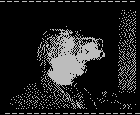
Controlled by web users
Real Remote Guided, by Antonio Lomas, features a subject who is "blinded" while the spectators / speakers on the internet and in the physical space, are able to see what the subject could see in normal circumstances.
GPS and web cam are combined with a laptop linked to the net through telecomunicaton systems (cellular telephony and/or wireless).
On the web page, the web guides see the images from the camera worn by the artist, as well as map images that define his location so that they can send him instructions, guiding him through a space of real intervention. The artist can only see the instructions sent by the users and the map images of the GPS system.
The idea is to represent, in a playful way, how new technological systems can take control. So, spectators are invited to take that control and to manage it. (Posted by Régine Debatty)
Posted by Regine at 03:01 AM | Comments (0)
December 18, 2004
The Living Room

A narrative installation puzzle
"The Living Room", by American artist Victoria Fang, is a narrative puzzle installation. Players enter a space containing 3 rolling units with screens in them and 21 clues painted on the floor. They have to move panels with LCD monitors to solve a whodunit murder mystery. Correctly positioning the units triggers filmed scenes that play back across the three separate panels, and these scenes give the player new clues to trigger the next scene. Players get a different spatialized experience with each scene, as the scenes are constantly changing position, thus working as a giant physical puzzle that houses a narrative puzzle.
This project is designed as an entertainment experience that focuses on the cathartic release of built-up emotional tension, through the use of mobile and wireless technology.
"The Living Room" has received a nomination for Transmediale award 2005.
(PDF of the project) (Posted by Régine Debatty)
Posted by Regine at 12:31 PM | Comments (0)
December 09, 2004
Summoned Voices
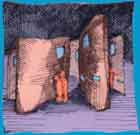
Interactionfields
Summoned Voices--by Iain Mott and Marc Raszewski--acts as a living memory of people and place. It consists of a series of door installations each with an intercom, sound system and a computer that is networked to a central file and database server. The design metaphor of the door presents a familiar scenario, that of announcing oneself at a doorway and waiting for a response from persons unknown. Signage instructs the public to speak, make sounds or sing into the intercom. Their voice is stored and interpreted, and results in local playback composed of the individual's voice with those that have gone before. Summoned Voices acts as an interpreter of sound, a message board and an imprint of a community - a place for expression, reflection and surprise.
Summoned Voices is one of the 22 projects catalogued by Mirjam Struppek for her thesis Interactionfield - Public Space in the Digital Age (2002): "The public space is a field, which is created and becomes alive through various forms of interaction.
Thus interactive art with its life proximity, communicative issues and reflection of the power of the modern technologies is well suited to be linked with the urban public space. This information platform presents detailed some selected interactive media projects, which went consciously into the urban public space. The analysis, categorization and questionaire with the producers of these 22 examples show how new media can be alternatively used, in order to contribute to the rediscovery and reactivation of the urban space and to lead to new interaction qualities. In the open expandable list further projects are collected. With the time an archive can develop, with examples, that show new ways in dealing with the public space. The links section presents various conferences, research projects, articles and specialized artists that related to this topic."
Posted by jo at 06:36 PM | Comments (0)
Are cell phones new media?

re-narrating cities via nomadic technologies
"Multiuser environments in cyberspace have frequently been regarded as utopian spaces in which users could project their imagination. When communities are shaped in a hybrid space, mobile phones become new media tools for creating novel and unpredictable imaginary spaces, re-narrating cities. Fixed Internet users do not have the ability to move through physical space. But the emergence of nomadic interfaces represents a chance for such imaginary spaces to be enacted and constructed in physical space.
Nomadic technologies have a twofold role in the construction of playful/narrative spaces. First, they allow virtual spaces to be mobile, bringing them into the physical world. Second, when used to play games, they free the game from the game board or the computer screen, making it possible to use the city space as the game domain." from Are cell phones new media? by Adriana de Souza e Silva [Related]
Posted by jo at 12:44 PM | Comments (0)
December 02, 2004
Mobile Confessional

Broadcasting Sin
The scenario of the Mobile Confessional is as follows: when you see the vehicle (called projectCAR) while stuck in traffic, you can call in to hear the message: "Welcome to the Mobile Confessional. Our service provides callers a safe and anonymous place to confess their sins to the world while commuting in Los Angeles. Your confession and an appropriate penance will be scrolled across the electronic sign in the back of the mobile confessional vehicle. Please, take a moment to share your sins with the world, so that all may forgive you."
This is only just one of the projects of Design and Technology for Mobile Experiences that tries to understand how design and technology can create compelling mobile experiences.
You are invited to attent final presentations and guest critique for the Interactive Media Division Graduate Seminar Design and Technology for Mobile Experiences, Monday December 6th from 10am-12n in the Zemeckis Media Laboratory, Los Angeles.
This modern way to make confessions reminded me of a project of Louise Wictoria Klinker and Andrea Berlinger (students at the Royal College of Art in London): the remote confession kit for catholic priests.
Originally blogged by Regine at near near future
Posted by jo at 09:01 AM | Comments (0)
December 01, 2004
Vena Amoris
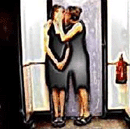
A Direct Digital Bloodflow
Vena Amoris, by Helen Paris, is a one-to-one performance which takes place on a mobile phone. (love vein/vain): Egyptians believed that the third finger of the left hand followed the vena amoris. The vein of love that ran directly to the heart. A direct, ‘digital’ blood flow. Vena amoris is a journey of narcissism and self obsession, employing both visceral and virtual means in an exploration of the perils of self desire: the danger of leaning too far over the black pond of the ever-present screen and slowly becoming captivated, immobilized in the quest for the perfect pixilated image.
"In Vena Amoris...I set out to renegotiate the boundaries of audience/performer relationships, in order to create a performance where I, as performer, would neither look nor be looked at. A one-to-one interaction was designed - not through face-to-face communication, but rather relayed via a cell phone. This decision suggested a theatrical architecture through which I could explore the degree of contact possible between audience and performer. It was accentuated by my desire to confront what and how we communicate with one another, particularly in the light of increasing digital technologies. Over the course of the installation/performance, audience members would be invited to join me, one at a time, in a series of explorations of narcissism, isolation, and immobilization, in which the direct contact and communication between performer and audience was central, and in which lone journeys converged." from Crossing Wires/Shifting Boundaries.
Posted by jo at 10:18 AM | Comments (0)
November 10, 2004
cyberPRINT
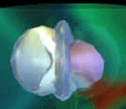
Bodies: Inside Out
cyberPRINT is a virtual reality dance environment...(W)hile a dancer performs on stage, he or she is wearing wireless sensors that monitor key physiological signs (respiratory and muscle activity, cardiac activity and the nervous system). Then, these measurements are captured in real-time during a performance and projected via colorful 3D renderings on a screen for the audience to watch...You can read the main write-up about the cyberPRINT project, which includes a good overview, descriptions of the technologies and images.
Multimedia choreographer and artist Yacov Sharir, the creator of the cyberPRINT project, conducted a workshop about this program at this September's Symposium on Arts & Technology. Here's how this workshop is described:
"The cyberPRINT is a real time Virtual Reality (VR) environment that totally surrounds a dancer during performance. This electronic architectural and musical bio-feedback system is driven by physiologic data drawn from the performer via special sensors attached to her body and transmitted wirelessly to computers which, in turn, generate and project a especially designed and programmed 3D/music world in real time. The resulting "architecture of being" offers multiple expressive choices as its multidimensional character undergoes continuous change. Although the use of the body to electronically drive media events is not new, most of the existing works have paid little or no attention to the potential of interactive 3D and aural virtual environments. Nor have they been so technologically advanced, interdisciplinary involved, or spatially focused as the cyberPRINT. The cyberPRINT has been nationally and internationally performed with success since May 2000." [via]
Posted by jo at 10:37 AM | Comments (0)
November 06, 2004
The Book of Rage and Longing
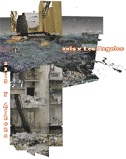
Raging by the Book
In ancient Greek comedy, parabasis named 'a part sung by the chorus, addressed to the audience in the poet's name, and unconnected with the action of the drama.' Calling themselves 'the bodies of rage and longing,' six artists and filmmakers based in the United States - Dimitri Kotsaras, Mr. Flo, Melissa Longenecker, Jennifer Nelson, Michael Wilson, and Natalie Zimmerman - have devised an ongoing, collaborative project to promote parabasis transnationally. With foci in Los Angeles and Athens, The Book of Rage and Longing stages an interrogative return to the putative birthplace of Western democracy. Viewers submit textual or visual rants, connected or unconnected with the daily unfolding dramas of wars worldwide. Unedited, these texts and images are projected on a rooftop facing the Acropolis. An 'interpretive/administrative committee' modifies these contributions, reshaping them into the titular book, segments of which a group of Greek singers then performs. Rea! d in the aftermath of this year's presidential election, these instances of parabasis have begun to seem rather more tragic than comic, as when one self-styled poet opines, 'From those who live like leeches on the people's lives,/ We must take back our land again,/ America.' - Ramsey McGlazer, Rhizome's Net Art News, November 5, 2004
Posted by jo at 10:25 AM | Comments (0)
October 28, 2004
MapTribe
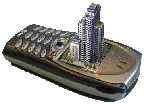
A tool for collaborative mobile learning
MapTribe is a software application for mobile phones. It enables group of users to see each other's position on a city map on the screen display, and to add on this shared map a certain number of objects that will positioned on the map according to the user's real position in the city.
MapTribe is based on the idea that every person retains and develops over time an image of the spaces s/he lives, which may be quite different from the physical inhabited place. It is commonly experienced, in fact, that places are enriched of psychological features that transform their perception. MapTribe is a tool for exchanging and comparing these personal images of the city among a group of friends. The tool we are developing helps people in analysing, capturing and visualizing this mental structure and to share it in a social network. From the negotiation of the differences between the maps of each participant in the group, a common understanding raises, an informal learning obtained by each user of the system about the image of the city.
Posted by jo at 10:37 AM | Comments (0)
Cell Phone Drum Machine

Collaborative Rhythm Generator with an SMS Interface
Cell Phone Drum Machine is a rhythm generator that can be controlled by users with their phones by sending text messages. Here's how it works: the operator links his/her phone to the computer and starts the drum sequencer. Users can then send special SMS commands to the operator's phone that controls the rhythm. The on-screen display shows from which phones commands originated.
Matt Hall and John Watkinson will present the project at dorkbot-nyc on Wednesday, November 3rd, 7pm at Location One in SoHo.
Posted by jo at 10:08 AM | Comments (0)
October 20, 2004
Public Displays of Affection
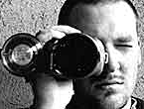
Affect and its Exhibition in Public
Public Displays of Affection
An Interdisciplinary Graduate Student Conference
Visual and Cultural Studies Program
University of Rochester
Friday, April 8 & Saturday, April 9, 2005
CALL FOR PROPOSALS
Civility can be viewed as a series of performances that generate a range of emotions, including the patriotism of war, the joys of shopping, and the fear of urban crime. The public display of affection constitutes a contest of meaning in which various appeals are made to organize the emotional life of the individual and the rules of decorum. To be convinced of this idea one only has to turn on the television. From the not-so carefully scripted emotions of the recent Presidential debates, to the ongoing pageantry of heteronormative romance, to the proscribed images of mourning for war casualties, it appears that the politics of putting your heart into the public sphere are by no means certain, but certainly meaningful.
PUBLIC DISPLAYS OF AFFECTION aims to explore the value of affect and its exhibition in public. Disturbed by formations of the public sphere as a wholly rational space for the exchange of collective ideas and actions, we turn instead towards the multiple meanings or uses of public feelings. We are interested in the specificity or uniqueness of emotions and how they shape historical moments and geographic sites.
We invite proposals from across disciplines, research interests and theoretical persuasions that engage with P.D.A. through specific forms of display: museums, galleries, mass media, film, theatres, festivals, etc. Possible areas of inquiry might include, but are not limited to:
Nationalism and/or spectacular nations
Political protest
Public/private space
Public sex
Marriage
Family
Feminism
Queer history and theory
Empathy, sentiment, depression, rage and other kinds of affect
***DEADLINE for submissions: December 15, 2004***
Submissions for 20-minute papers should be in abstract form (250-500 words). A self-addressed stamped envelope must accompany all submissions requiring return. Please include e-mail addresses with all submissions whenever possible.
Abstracts and inquiries may be sent via e-mail to: vcsconf @ mail.rochester.edu
Printed submissions should be sent to:
Organizing Committee for "Public Displays of Affection"
c/o Program in Visual and Cultural Studies
424 Morey Hall
University of Rochester
Box 270456
Rochester, NY 14627-0456
ABOUT THE PROGRAM
The Program in Visual and Cultural Studies is an interdisciplinary graduate program at the University of Rochester. Its focus is visual culture and critical theory; the Departments and Programs of Art and Art History, English, Film Studies, Anthropology, History, and Modern Languages and Cultures, as well as the Susan B. Anthony Institute for Women and Gender Studies, constitute its academic base. Web site: http://www.rochester.edu/college/AAH/
Posted by jo at 02:39 PM
October 15, 2004
Love One Day

Time, Space, Love
'love one day' was a real one-off action through time and space, presented live online and later as a cinematic video installation. Two people from two distant parts of the UK started a long journey to London. They met in a hotel bedroom and within 24 hours of starting their journey, they left. 'love one day' explored the communication between two people whose anticipation of love was heightened by the unique circumstances of their journey. It documented the emotions, thoughts, observations and behaviour of two 'matched' individuals as they traveled towards each other and met one day. 'love one day' investigated psychological motivations, how we communicate and interact with others and how we are affected by our environment, space and time.
A unique 'love one day' dating website was created. This allowed people to submit their personal profile and browse/chat amongst other candidates looking for the perfect match during one month. The website took on a similar format to that used by online dating agencies with specific questions designed to recruit two protagonists for a journey to meet in London. 'love one day' was publicised and promoted through online listings, press and 'satellite venues' (public spaces and institutions supporting the project) as well as the website's established visitors and target audience.
Two people from a selection of 'matched' couples via the 'dating website', were interviewed and chosen to become the main protagonists of this experience. People prepared to accept the role of protagonist by embarking on an emotional and physical journey to meet someone they have never met in a hotel bedroom were sought. They were chosen on the basis that they made a good love match.
The two selected protagonists were each given a mobile phone to continue their communication by phone, in text and images so they could get to know one each other a little more before their journey started. No direct contact was allowed until they met for the first time in the hotel during filming. The entire journey was filmed and the telecommunications were documented live on the love one day website. The protagonists later met with a relationship psychologist to feedback about their experience.
'love one day' is a project of completely naked.
Posted by jo at 01:01 AM | Comments (0)
October 11, 2004
Platfrom

Routed Narratives
Platfrom, by Rachel Baker, uses the platform of the mobile phone within a very specific context - the train journey. A series of playful SMS messaging scenarios will make a relation between mobile phone and rail network as communication systems. Focusing on privatised, proprietary networks -the railway and the mobile phone -the project will invert them into opportunities for public and group interaction. It offers moments for train culture and SMS culture to integrate, taking advantage of a journey's incidental nature (delays etc.) with unknown consequences by creating a common gateway between train traveller and static web user and including them both in a narrative along a particular route. The narrative at this stage is dictated by the route from South to North and the contiguous cities and landscape. Read more [PDF]. Also read an essay by Matt Locke.
Posted by jo at 11:52 AM | Comments (0)
October 07, 2004
The Wireless Invisible

Sound Tracks and Data Footprints
"Stalking the footfalls and echoes of the wireless invisible" by Tobias C. van Veen, Horizonzero, Issue 15: New Movements in Digital Music
When what is "useful" is defined in terms of its market, when GPS directions lead to the nearest McDonald's, then wireless art becomes yet another pervasive intrusion, a one-way dictation. The ephemeral terrain of wireless art in all its forms is a floating, multicast struggle where the century old battles of radio are being re-played out. Yet - this time with Open Source software and technologies; with artist-driven hardware development; with a programmer's technique and a hacker's verve; and, like a hive, with a collective approach to anticipating the enemy's moves on the global level. This machine aims to engage the participant in the game: encouraging the step of becoming a content-creator rather than just a passive receptor, disrupting the sender/receiver of communication, the fortress of static/noise, of what defines efficiency and usability. The target of producing ever new and publicly-oriented ways of engaging life through the tendrils of technology is in sight. This disruptive yet productive desire has been a persistent dream since the avant-garde encountered radio one hundred years ago. Read article.
Posted by jo at 08:36 AM | Comments (1)
October 05, 2004
Life: a User's Manual, Part 2

Inhabiting Image Spaces
Commissioned by and currently on exhibit at Impakt Online, Life: a User's Manual locates the city of Utrecht as its game board, where every story, every piece stands on its own, but is part of an intricate jigsaw puzzle. Both public physical spaces and private interior spaces contain traces of fragmentary personal [hi]stories tied together by an invisible network of media. How people inhabit the hidden 'image spaces', discovered by a wireless surveillance camera scanner, while at the same time inhabiting physical outdoor spaces, was revealed through the daily practice of walking during the Impakt Festival 2003. The findings of Michelle Teran's walks have been arranged on a map of Utrecht's secret transmissions.
Life a User's Manual is a series of walking performances taking place in different cities (see an earlier post on this site), based around the activity of tapping into the unencrypted transmissions of wireless security cameras using a 2.4 Ghz receiver. In a search for the hidden stories within the city, a walk through the urban streets reveals an invisible network of watched spaces. The unencrypted signal from the camera leaks into public space, making it easily viewable from the street. This puts us in an interesting moment of uncertain inhabitation, of being in two spaces at once.
A tiny fraction of the spectrum of the airwaves has been allocated for public use, as if space and the air are not public already. Taking advantage of this unlicensed part of the spectrum, we have seen an increased used of wireless devices that are all fighting for use of this narrow band. Use of wireless [wifi] networks, cordless phones, bluetooth, and wireless cameras transmitting on this frequency contributes to an already existing invisible world of electromagnetic fields and frequencies that saturate our bodies on a daily basis. It becomes impossible to separate our bodies from the traffic reports, surveillance video, phone calls and pop songs of others. We wear each other's information.
Posted by jo at 11:10 AM | Comments (0)
September 29, 2004
The Invisible Train
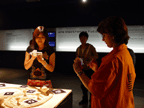
The Invisible Train is a mobile, collaborative multi-user Augmented Reality (AR) game, in which players control virtual trains on a real wooden miniature railroad track. These virtual trains are only visible to players through their PDA's video see-through display as they don't exist in the physical world. This type of user interface is commonly called the "magic lens metaphor".
Players can interact with the game environment by operating track switches and adjusting the speed of their virtual trains. The current state of the game is synchronized between all participants via wireless networking. The common goal of the game is to prevent the virtual trains from colliding. Watch the Quicktime video. Invisible Train will be demonstrated at the International Symposium on Mixed and Augmented Reality (ISMAR 2004) in Arlington, VA.
Originally from waxy. Reblogged by tripp USC Interactive Media Division blog, and by emily on near near future.
Posted by jo at 12:59 PM | Comments (0)
September 28, 2004
oh that ether!

More on Sky Ear
Rereading David Pescovitz’s article State of the Artists, where he discusses Sky Ear–a “surreal electric ‘cloud’ of mobile phones and helium balloons that connect participants with the electromagnetic ether…," I am reminded of early radio.
It was Guglielmo Marconi who first exploited Heinrich Herz’s discovery of electromagnetic radiation and demonstrated that radio waves could be used to transmit morse code over hundreds and then thousands of miles. When he first introduced wireless to America, during the popular America Cup races in 1899, the press hailed him as a hero and a wizard. Wireless itself evoked “psychic metaphors” (see Susan Douglas’ great book, Listening In). It was magic; Popular Science Monthly wrote that it was as if “the nerves of the whole world (were)…being bound together.” And the reputable scientist, Sir Oliver Lodge, one of the leaders of the British Association for the Advancement of Science, suddenly began praising mediums, insisting the dead don’t die and describing contact with the spiritual world. The connection between radio, the ether and spirituality ran strong.
Sky Ear, which is designed to acquaint you with these same "hidden mysteries of the wireless spectrum” by triggering high-intensity colored LEDs within the cloud, seems to be falling on a different sensitivity in 2004, with one correspondent remarking that “putting mobile phones into the clouds just to blink colors is ridiculous.”
Sky Ear had its last public launch in England on September 15, and according to its web site, there are no confirmed "flights" planned for the future, although talks go on. For more on Sky Ear and other works by Usman Haque. For more on radio: Susan J. Douglas, Listening In: Radio and the American Imagination, Times Books, 1999.
Posted by newradio at 04:19 PM | Comments (0)
September 26, 2004
QUIXOTE

A Moblog Performance in Turin
During the week of September 23, 2004 Quixote, a puppet, will explore Turin travelling within a network of writers, undefined at the beginning and growing day by day. Their task will be to accompany him around sharing his story with us, chronicling his journey through the city.
Quixote's journey is tracked via a GPS/GSM system in order to show on the website the exact geo-location of each moblog post and to define the topology of the network arisen during the performance. The project is an ongoing investigation around digital mobility and social networks in relation to new forms of mobile expression and interaction.
As of March 2005, Quixote has a new moblog.
Posted by jo at 03:45 PM | Comments (0)
physical proximity
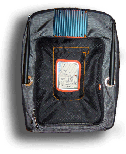
WiFi.Bedouin
Conceived and developed by Julian Bleecker, WiFi.Bedouin is a wearable, mobile 802.11b node disconnected from the global Internet. It forms a WiFi "island Internet" challenging conventional assumptions about WiFi and suggesting new architectures for digital networks that are based on physical proximity rather than solely connectivity. Most significantly, WiFi.Bedouin facilitates the creation of a truly mobile web community.
WiFi.Bedouin is designed to be functional as well as provocative, expanding the possible meaning and metaphors about access, proximity, wireless and WiFi. This access point is not the web without wires. Instead, it is its own web, an apparatus that forces one to reconsider and question notions of virtuality, materiality, displacement, proximity and community. WiFi.Bedouin is meant to suggest that what are often considered two entirely separate realms - virtual and physical worlds - are actually a much more entangled hybrid space. (from the web site)
Posted by newradio at 02:06 PM | Comments (0)
September 25, 2004
Leaders or Followers?
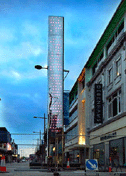
State of the Artists
"Do we drive technology or have we become just passengers? How do we navigate a reality where the lines between the virtual and real are blurred? What is our relationship to our environments, and each other, in an increasingly mediated world?
These questions have been at the heart of electronic art since its birth in the 1960s. It was then that Bell Laboratories Telephone engineer Billy Kluver collaborated with future-minded artists like John Cage and Jean Tinguely on groundbreaking works incorporating, and often critiquing, technology's state-of-the-art. Of course, that tradition continued through the dawn of the digital age and the emergence of the Web. And now it's rising in the vast spectrum of wireless telecommunications." Continue reading David Pescovitz's article at TheFeature.
Posted by jo at 12:06 PM | Comments (0)
September 21, 2004
Life: A User's Manual
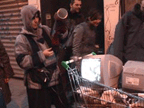
Subverting Surveillance Tactics
Life: A User's Manual is a public performance by media artist Michelle Teran where she dresses up like a bag lady and carries an antenna made out of a soup can while pushing a shopping cart full of televisions along a designated route in Brussels, Belgium. The antenna is connected to a 2.4 GHZ X-10 video scanner which picks up signals from wireless cameras deployed by stores, homes, or police in the buildings and neighborhoods she passes. The found signal is then displayed on the TV in her cart. This type of surveillance is a theme of Teran's work that attempts to make hidden or private CCTV streams into public performance and online mappings. Really interesting take on the act of subverting existing surveillance tactics by displacing the context of the medium.
From her description: “The city is a game board, where every story, every piece stands on its own, but is part of an intricate jigsaw puzzle. Both public physical spaces and private interior spaces contain traces of fragmentary personal [hi]stories tied together by an invisible network of media. How people inhabit the hidden ‘image spaces’, discovered by a wireless surveillance camera scanner, while at the same time inhabiting physical outdoor spaces, is revealed through the practice of walking.” From jonah at coin operated.
Posted by jo at 07:39 AM | Comments (1)
September 20, 2004
Tactical Sound Garden [ TSG ] Toolkit

Shaping Space Through Sound
The TSG Toolkit is an open source platform for cultivating public "sound gardens" within urban environments. The TSG offers the urban dweller a participatory role in shaping the soundscape of contemporary public space: it enables anyone with a WiFi enabled mobile device (handheld, laptop, etc) to "plant" sounds within a networked, 3D audio environment. These "plantings" are mapped onto the coordinates of a physical location, overlaying a collaboratively constructed soundscape onto a specific urban space. Wearing headphones connected to a WiFi enabled device, participants drift though virtual sound gardens planted by others as they move through the city.
Posted by jo at 12:37 PM | Comments (0)
September 15, 2004
Elastic Test
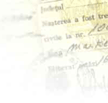
eliminate undesirable foreigners
Immigration authorities around the world need our help!! Use this website to contribute your ideas or proposals for an elastic test that can be devised to eliminate undesirable foreigners.
Immigration Statutes around the world are generally written using vague or abstract notions such as good moral character. It is the messy job of the courts to make such abstractions concrete, to objectively test and measure the moral character of a foreigner, and to eliminate arbitrary or contingent factors from the immigrations process. Join us in doing our part. We will invent, develop and implement numerous elastic tests, which can help the authorities contain and eliminate undesirable foreign bodies. Some of these tests will then be executed on our foreign test subject in a series of live and webcast performances.
Robert Lawrence (UNIMAS, Sarawak, Malaysia and USF, Tampa, Florida) wrote to us about this project on July 22, 2004. He said:
This project from the beginning has had an open door for participation through the web, but currently we are looking for ways to decentralize the project in more significant ways. Some issues related to this on which we are cogitating:
1. Given that our interventions require location-specific collaborations, how can the role of trans-local media, networks or distribution channels be re-imagined?
2. How can the project become less centralized? What are some models of de-centered cooperation we can try to implement – what is the advantage of a distributed network of creators in this case?
3. How might considerations of distribution and re-usability expand the current scope of the work?
4. One of the important aspects of the work is initiating and facilitating new relationships between local communities and structures – is this sustainable?
As we continue to evolve this project and develop ways to ‘turn it loose’ we are very interested in engaging in dialogue, theoretical and practical collaborations, and discovering and developing new models for distance collaboration.
Another of Lawrence's projects Un Message, Evidemment was blogged here.
Lawrence had this to say about it:
"The ‘story’ will be told entirely in the recorded messages that the foreground characters are listening to on their cell phones. These stories will be selected, synthesized and/or adapted from the contributions at this website and other venues. These stories will be gathered in several ways. Whenever the film in progress is shown at festivals, workshops or any other venue people will be asked to contribute storys by phone, sms, email. Participants will be encouraged to engage the performance on any number of levels.
We are also seeking opportunities to workshop the film doing shooting or writing. The “completed” film provides another dimension of the viewer/performer dynamic. At every stage of production, post-production, and presentation the ‘final form’ of the film will be negotiable. It will be shown in a user interactive form on the web, and in ‘concrete,’ though varying, versions in festivals and the usual film art venues – It may not ever appear in the same form twice."
Posted by jo at 08:46 AM | Comments (0)
September 12, 2004
mobile performance group
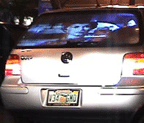
(auto)mobile performances
04.15.04 Downtown Orlando FL: Using the automobile as a mobile performance apparatus MPG presented a live performance which included real-time video and audio processing techniques. This project used two cars, one with audio performers the other with video performers. Using wireless networking and a FM transmitter the two cars where able to keep in sync and perform together as they moved through the city. Performers where Laura Oxendine, Adam Roberts, Martha Garzon, Damion Waters, Bryan O'neal, Ben Hustis, Julius Santiago, James Auten, Chester Udell, Jamie Tauler. Project Leaders where Nathan Wolek, Matt Roberts.
MPG:Mobile Performance Group is a collective of new media artists interested in finding new ways to present art outside of traditional venues. The Group was founded by Matt Roberts and is based in Florida. Using custom video and audio software instruments in real-time, and original video and audio recordings, Roberts and Wolek will present a meditation on the Florida Landscape which will be realized as an improvised new media performance at the New Forms Festival, Vancouver, Canada on October 24, 2004.
Posted by jo at 04:46 PM | Comments (0)
September 08, 2004
CitiTag

mediating social experience
CitiTag is a wireless location-based multiplayer game, designed to enhance spontaneous social interaction and novel experiences in city environments by integrating virtual presence with physical. In the first version of CitiTag you roam the city with a GPS- and WiFi-enabled iPaq PocketPC in search for players of the opposite team that you can ‘tag’. You can also get tagged yourself if one of them gets close to you. Then you need to find a friend to free you. Urban space becomes a playground and everyone is a suspect.
Posted by jo at 11:03 AM | Comments (0)
September 05, 2004
Work by Usman Haque
Usman Haque designs interactive architecture systems and researches how people relate to each other and their spaces. "The domain of architecture has been transformed by developments in interaction research, wearable computing, mobile connectivity, people-centered design, contextual awareness, RFID systems and ubiquitous computing. These technologies alter our understanding of space and change the way we relate to each other. We no longer think of architecture as static and immutable; instead we see it as dynamic, responsive and conversant. Our projects explore some of this territory." Performative works include:
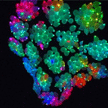 Sky Ear, 2004: This non-rigid "cloud", made up of several hundred glowing helium balloons will be embedded with mobile phones. As visitors to the event call into the cloud to listen to the distant electromagnetic sounds of the sky (including whistlers and spherics), their mobile phone calls will change the local hertzian topography; these disturbances in the electromagnetic fields inside the cloud will alter the glow intensity of that part of the balloon cloud. Quicktime video: 19 MB
Sky Ear, 2004: This non-rigid "cloud", made up of several hundred glowing helium balloons will be embedded with mobile phones. As visitors to the event call into the cloud to listen to the distant electromagnetic sounds of the sky (including whistlers and spherics), their mobile phone calls will change the local hertzian topography; these disturbances in the electromagnetic fields inside the cloud will alter the glow intensity of that part of the balloon cloud. Quicktime video: 19 MB
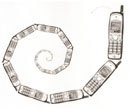 Japanese Whispers, Tokyo (2000): Similar to the children's game known as "Chinese Whispers" or "The Telephone Game," this project looks at how a message is changed by being passed from one mechanism to another--in this case the cellphone.
Japanese Whispers, Tokyo (2000): Similar to the children's game known as "Chinese Whispers" or "The Telephone Game," this project looks at how a message is changed by being passed from one mechanism to another--in this case the cellphone.
Cellphones are laid in a circle and calls are initiated from one phone to another in a variety of patterns with differing results. The sound degrades at each step as it is transformed from analog to digital and back again, emphasising the circular nature of communication. The iterative process of the feedback loop amplifies miscommunications inherent in the transmitting of information. Quicktime video: 9.2 MB
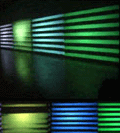 Infinitum Ad Nauseam, Tokyo (2000): The project is a video/audio performance installation which requires the explicit participation of the audience. Essentially, the system uses video and audio feedback to create sounds (from images and movements) and images (from sounds and movements). 4 video cameras, 4 video projectors, 2 video mixers and an audio mixer are used to initiate a massive feedback loop of video-video, video-audio, audio-video and audio to audio. This creates dynamic real-time images and sounds in "conversation" with the visitors or performers. There are no pre-recorded images and no computerised images used in the installation. Videos>>
Infinitum Ad Nauseam, Tokyo (2000): The project is a video/audio performance installation which requires the explicit participation of the audience. Essentially, the system uses video and audio feedback to create sounds (from images and movements) and images (from sounds and movements). 4 video cameras, 4 video projectors, 2 video mixers and an audio mixer are used to initiate a massive feedback loop of video-video, video-audio, audio-video and audio to audio. This creates dynamic real-time images and sounds in "conversation" with the visitors or performers. There are no pre-recorded images and no computerised images used in the installation. Videos>>
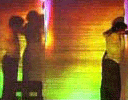 Changing Faces of Gesture, Tokyo (2000) with Charlotte Boye-Christensen (Choreographer/Dancer): The performance consists of one person and 2 to 4 large video projections. Using a simple video feedback system (where a video camera is pointed towards the screen upon which its image is being projected) coupled with an audio feedback system, complex images are created in realtime which are manipulated by the performer's movements. Images created resemble reflections in a puddle; these can be coloured using filters on both the cameras and the video-projectors. Furthermore each projector can be separately controlled to multiply the effects and simulate everything from a solitary dancing figure to a bustling crowd of people. Videos>>
Changing Faces of Gesture, Tokyo (2000) with Charlotte Boye-Christensen (Choreographer/Dancer): The performance consists of one person and 2 to 4 large video projections. Using a simple video feedback system (where a video camera is pointed towards the screen upon which its image is being projected) coupled with an audio feedback system, complex images are created in realtime which are manipulated by the performer's movements. Images created resemble reflections in a puddle; these can be coloured using filters on both the cameras and the video-projectors. Furthermore each projector can be separately controlled to multiply the effects and simulate everything from a solitary dancing figure to a bustling crowd of people. Videos>>
Posted by jo at 11:42 AM | Comments (2)
August 31, 2004
imaginary and symbolic meetings
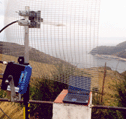
Walter Benjamin >< Marcel Duchamp
From Franck Ancel: "During a trip to Barcelona in 1997, a railway workers’ strike blocked off the French-Spanish border to me. This chance situation enabled me to explore two border villages at the feet of the Eastern Pyrenees. Two significant structures caught my attention: the Walter Benjamin memorial in Port Bou on the Spanish side called Passage by Dani Karavan, and, on the French side, the Hôtel Belvédère du Rayon Vert built by Léon Baille, the Perpignan architect.
On one side there is this memorial to Walter Benjamin who committed suicide on 26 September 1940, and on the other a building in the boat style of the 1930s containing a former cinema and theatre, listed as a 20th-century heritage building, whose name, for me, is immediately synonymous with Marcel Duchamp.
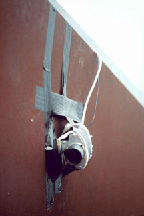 I would have to wait until the electronic projection of 23 November 2002 at the convent of La Tourette (built by Le Corbusier and Xenakis) to be able to question artistic and aesthetic boundaries in a more direct manner, in order to find out the necessary information for a search that has enabled me to talk today about these two locations in Catalogne.
I would have to wait until the electronic projection of 23 November 2002 at the convent of La Tourette (built by Le Corbusier and Xenakis) to be able to question artistic and aesthetic boundaries in a more direct manner, in order to find out the necessary information for a search that has enabled me to talk today about these two locations in Catalogne.
Benjamin’s thought and Duchamp’s art are scheduled to be brought into play during the weekend of 27 September 2003 at this Franco-Spanish border location, and this is seen as an imaginary and symbolic meeting. It is a result of, and follows, the mark that these two great figures have left behind them which has totally transformed artistic and aesthetic boundaries in the 20th century.
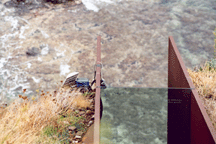
This production will cross physical boundaries and will link the two locations of Port Bou and Cerbère. In other words, the Walter Benjamin memorial in Spain and the Hôtel du Rayon vert in France. The event will attempt to mark the boundaries of the art disciplines and will be mainly held in the Hôtel’s theatre auditorium where our audiovisual reception will be held.
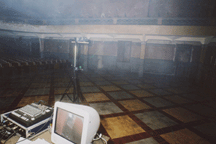
These days, it is almost considered to be an essential requirement that this comparison will use new technologies. It will therefore be through the use of wifi wireless network, together with interactive software, that we will travel beyond the physical boundary.
Our journey through and between these two locations reconnects a whole set of different information:
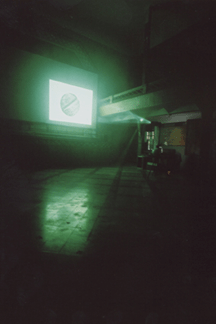
- The fictional novel Traité d’abrégé de littérature portative (Abridged Treatise on Portable Literature) by Enrique Vila Mata and published in 1985, and which depicts Duchamp and Benjamin in Port Bou as part of a secret society linked to the number 27,
- The Rayon Vert laser created by Dani Karavan for the Electra exhibition in 1983 which linked the Musée d’Art Moderne (Modern Art Museum) of Paris, the Eiffel Tower, and the Assur Tower located in the Défense quarter,
- The photograph entitled Rayon Vert by Denise Bellon for Duchamp, which was given to the set designer Frederick Kiesler, for the superstition room at the surrealist exhibition, held in Paris in 1947, the same year that Music for Duchamp was composed by John Cage.
Convergence points of the universe that have hitherto been parallel, and overlooked links, will appear at this event. This fake dimension will, however, can give another meaning to a trip, appropriate to our world, which is henceforth informational and chaotic.
This gathering consequently offers you a short-lived journey across a virtual world of concepts. It will extend the enquiry into the notion of the decline of the “aura” in the wake of computing technology, and serves as homage to Walter Benjamin."
Contact Franck at franck.ancel at wanadoo.fr
Posted by jo at 11:13 AM | Comments (0)
August 30, 2004
Christophe Bruno
FashMobs and WiFi-SM
I came across this post on boing boing today: it suggests the possible fascist undertones of flash mobs, "depending of course on who organizes the particular gathering, their motivation..." It then refers to Christophe Bruno who has created a net art work called Global Artists. Bruno asks "Imagine that the history of the world was turned upside-down and that the historical characters who left their mark in our schoolbooks, were reincarnated as... artists. What works of art would they produce?" One example he gives is FashMobs by A.Hitler:
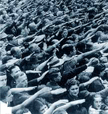 "I created a website where people can leave their mobile phone number. The idea is that when the number of people is large enough, a SMS instruction is sent to all of them simultaneously by the server. When they receive it, people have to perform the instructions. The instructions are simple ones, like raising an arm, but the effect is amplified by the fact that many people do it in the same place, at the same time, as in a symphonic orchestra."
"I created a website where people can leave their mobile phone number. The idea is that when the number of people is large enough, a SMS instruction is sent to all of them simultaneously by the server. When they receive it, people have to perform the instructions. The instructions are simple ones, like raising an arm, but the effect is amplified by the fact that many people do it in the same place, at the same time, as in a symphonic orchestra."
Similarly disturbing is WiFi-SM: Feel the Spectacle of Pain. 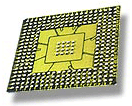 "You have the impression that the disasters of the world do not touch you anymore? You feel vaguely sorry for other people's misfortunes but you don't feel the inner urge which used to make you help your neighbour? WiFi-SM is the solution!"
"You have the impression that the disasters of the world do not touch you anymore? You feel vaguely sorry for other people's misfortunes but you don't feel the inner urge which used to make you help your neighbour? WiFi-SM is the solution!"
Bruno reminds us that, as always, technologies can be abused and/or produce the opposite effects for which they were orginally intended. Or, is this what they were orginally intended to do?
Posted by jo at 10:59 AM | Comments (1)
August 28, 2004
Bikes Against Bush

Breaking News! Josh Kinberg Arrested!
Josh Kinberg (see our Bikes Against Bush post) was arrested [watch video] while being interviewed about his Road Writer bicycle. This news comes after I personally road in Critical Mass last night and a person in our riding group was arrested. HERE IS THE EMAIL about Josh word for word:
"...about 40 minutes ago Josh was doing an interview with Ron Reagan and in the middle of it the police pulled up. 20 minutes later a captain came down to the scene (all still while on camera with Ron reagan) and after some time arrested Josh. they took the bike too. Josh is OK. We were all shocked that it would happened like that. a crowd had formed and many journalist wondered into it. Josh was little shocked but, it was all peaceful and calm just very very frustrating and absurd. - YURY GITMAN"
From | alison | juliaset, 08.28.2004: 13.19.35
Read an article.
"Joshua was released from police custody at 11:00 AM on Sunday. Lawyers from the National Lawyer Guild believe that the case is a clear violation of the first amendment and should be thrown out. Joshua's bicycle, laptop, and cell phone have all been confiscated, however, and are being held until his court hearing. The court date has been set for Friday, 9/3, after the end of the RNC. An alternative link to the video can be found at http://dv.open4all.info/?postid=70"
posted by: yatta on juliaset
Read Josh's account of what happened.
Posted by jo at 01:25 PM | Comments (0)
ubiquitous computing and the production of space

Call for WiFi.ArtCache Participants
This is a call for contributions to art-technologists interested in contributing to the WiFi.ArtCache during its exhibition at Spectropolis October 1-4, 2004. Deadline for submissions is September 26th.
By simply coding to a provided ActionScript 2.0 API, Flash artists are able to create an interactive experience that changes based on how many people have downloaded their art object, how many people are currently interacting with their art object, or whether their art object is currently in range of the WiFi.ArtCache. Here are earlier posts about WiFi.ArtCache and Spectropolis.
The WiFi.ArtCache is a physical object server containing a standard WiFi 802.11 access point. When exhibited at the Spectropolis event at New York's City Hall Park in Lower Manhattan, the WiFi.ArtCache will contain a storehouse of art objects. Visitors to the event can download these art objects onto their 802.11 equipped laptops and experience the artists' interpretation of location and proximity effects.
Developer documentation and downloads can be found at:
http://wifiartcache.techkwondo.com/overview.jsp
http://artcache.techkwondo.com/overview.jsp
Please send submissions, questions and inquiries to wifiartcache at
techkwondo dot com.
General information about the WiFi.ArtCache concept can be found at:
http://www.techkwondo.com/projects/artcache/
Additionally, the WiFi.ArtCache will contain a generic storehouse of digital ephemera that visitors can upload and download to the server. Scratchy audio, yellowed digital documents, discolored image files and spoiled emails can all be found and dropped off at the WiFi.ArtCache.
WiFi.ArtCache was developed by Julian Bleecker with support from Eyebeam Atelier. This exhibition is sponsored by the Downtown Alliance, NYCWireless, the Lower Manhattan Cultural Council and Spectropolis. Spectropolis is curated by Wayne Ashley, Yury Gitman and Brooke Singer.
http://spectropolis.info
http://www.techkwondo.com/projects/artcache
http://www.eyebeam.org
http://www.nycwireless.org
http://www.lmcc.net
Posted by jo at 10:57 AM | Comments (0)
August 26, 2004
PING

Presence and Absence
PING, by Kate Armstrong, uses a telephone menu system to distribute active commands to participants who call in using cellular telephones. The choices made by the caller when navigating the telephone system produce directions for physical movement through the city.
PING comes out of psychogeographical inquiry, which focuses on the study of the effects of the environment on the perception, behaviour and mood of individuals. PING is intended to explore the interface between disparate fields such as situationist thought that focuses on subjective mood, generative psychogeography which introduces algorithms as a way to inspire movement through urban space, existentialism, and the interpolation of digital metaphors onto physical, analog space. Read "A Psychogeographical Account of PING and the PsyGeoConflux 2003" by Kate Armstrong.
Posted by jo at 11:08 AM | Comments (0)
August 25, 2004
Poetrica

Teleintervention
Poetrica is an investigation about reading and reception in cybrid and entropy situations. The project involves a series of visual poems conceived by Giselle Beiguelman with non-phonetic fonts (dings and system fonts), a DVD, digital prints, movie trailers and a teleintervention which allowed to anyone compose visual messages and submit them, by the Web or SMS, to three commercial electronic billboards located in downtown São Paulo, using the same typographic background she used in her nomadic poems.
Posted by jo at 07:51 PM
iki-iki phone
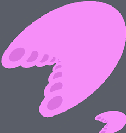
IKI-IKI Hoikuen
"IKI-IKI Phone is a multi-user, networked Artificial Life (=Alife) art game for the I-mode mobile phones. In this system, subscribed users can create Artificial Life creatures (=IKI-IKI pets), interact with these pets, feed them, take care of them, and evolve them. Networked users can also share their pets with other mobile phones users, trade them, watch them compete against each other, become friends with each other, create offspring and develop an IKI-IKI pet society. Users can also start communicating with each other through their shared pets."
A collaboration between Alan Dorin, Christa Sommerer, Laurent Mignonneau and the students of the Institute for Advanced Media Art & Sciences (IAMAS), Ogaki, Gifu, Japan. Read "IKI-IKI Phone: a Multi-user Alife Art Game for Mobile Phones."
Posted by jo at 06:30 PM | Comments (0)
August 20, 2004
murder
Those were the themes in an interactive, fictitious murder mystery and sightseeing tour developed by four graduates of the Canadia Film Centre's Habitat Lab, Toronto. The idea was to let participants tour the neighborhood while at the same time trying to solve the mystery. En route they visited the Gladstone and Drake Hotels, the Beaver Cafe and the DeLeon White Gallery, gathering clues and directions by dialing their cellphones, reading text messages, and examining physical evidence and computer displays at different sites.
The mystery/sightseeing tour was a prototype. It lasted only two days, but interesting developments were expected. Regrettably Ian Harvey, a journalist and one of the project's producers was the only person named in the Globe article.
Posted by newradio at 05:26 PM | Comments (2)
where are we eating?

Digesting Sound
where are we eating? is a translocal radio feast. Site-specific dining at ISEA 2004 and around the world. This is a project which aims to nourish. "We are interested in exploring hybrid transmission spaces dispersed and mobile modes of exchange, eating as a particpatory performance, cooking as a collaborative creation."
where are we eating? radio feast will be broadcast on 21-22 August 2004 on ÄÄNIRADIO 103.1 FM, online and on the streets of Helsinki where Grilli Radio will explore the local foodscape.
Posted by jo at 11:52 AM | Comments (1)
August 17, 2004
WiFi.ArtCache
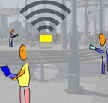
Local Networked Clouds
"The design challenge of this project is to create an apparatus that brings together physical proximity, narrative, interactivity and physical space in such a way as to engage a discourse about ubiquitous computing and the production of space."
WiFi.ArtCache reveals the leaky, spongy abutment joining our data and our physical world by tracing out the contours of networks. Through the limited range of WiFi systems, the Caches 802.11 radio creates a spatially constrained range of influence. Rather than relying on 802.11 WiFi technology to extend the reach of the Internet into physical space, WiFi.ArtCache uses 802.11 in a reverse mode of operation it relies on its limited range to create a small, local network cloud. See other Julian Bleecker projects at techkwondo
Posted by jo at 03:00 PM | Comments (0)
August 15, 2004
Umbrellas in the Net
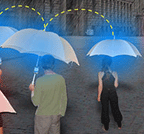
Spontaneous Wireless Mesh Networks
Gizmodo reports on Bluetooth Umbrella Networks: A team called "Umbrella.net" (no relation to Umbrella Corp, we hope) has developed a prototype system of Bluetooth umbrellas that facilitate "sudden, striking, and unexpected connections between people in public and urban space" by forming ad-hoc mesh networks when unfurled. As each umbrella is opened and added to the network, it lights as it comes online.
reblogged from Smart Mobs; posted by Paul Hartzog. August 13, 2004 at 09:46 AM
And Unstrung adds in Umbrellas in the Mesh:
In other words, create spontaneous wireless mesh networks that form when people put their umbrellas up -- and end when the rain stops.
This kind of mesh technology allows the devices themselves to act as nodes, passing data back and forth in an ad hoc setup, without a fixed connection to the wired Internet -- unlike the majority of commercial mesh products available.
The UMBRELLA.net project itself says:
UMBRELLA.net is a project exploring transitory or ad-hoc networks and their potential for causing sudden, striking, and unexpected connections between people in public and urban space. The project focuses on the theme of "coincidence of need", or how shared, yet disconnected activities can be harnessed into collective experiences. UMBRELLA.net examines how the haphazard and unpredictable patterns of weather and crowd formation can act as an impetus to examine coincidence of need networks. In particular, when umbrellas are opened and closed in public space. The project will attempt to highlight these informal relationships by creating a system of ad-hoc network nodes that can spontaneously form and dissipate based on weather conditions.
Now we finally know what those lighted umbrellas in Ridley Scott's film Blade Runner are.
Posted by jo at 01:05 PM | Comments (1)
August 08, 2004
Noderunner

Racing Against Time
Noderunner--by Yury Gitman, Carlos J. Gomez de Llarena--is "a competitive game (that) fuses the streets with wireless networks to convert the city into a playing board. Two teams racing against time must log into as many modes as they can and upload photographic proof to the server, documeting their progess." Noderunner won the Golden Nica for Net Vision/Net Excellence at Prix Ars 2003. Read more
Posted by jo at 04:02 PM | Comments (0)
August 05, 2004
Whitman's phones

Cellphone Performance
11 October 2002, Leeds, UK: (Evolution 2002: PROCESS) During his first visit to the UK, seminal American artist Robert Whitman produced a 30 minute cellphone performance based on a 1960's work he originally performed using payphones in New York City.
The performance in Leeds used 30 volunteers with cellphones stationed at pre-defined locations around the city centre. The volunteers repeatedly called a central telephone number and switch board situated in Millennium Square and, when their call was answered, gave a short description of their location. The resulting calls were mixed by Robert and relayed live through public address speakers to an audience in the outdoor square. The performance painted an aural description of the city at that given time.
During the 1960's Whitman distinguished himself with sophisticated theatrical works involving interaction between live performers and filmed images. For more information on this little-known artist, who along with with scientists Fred Waldhauer and Billy Klüver and artist Robert Rauschenberg, cofounded in 1966 Experiments in Art and Technology (E.A.T.), a loose-knit association that organized collaborations between artists and scientists, see Robert Whitman’s Telecommunication Projects by Bettina Funcke. As Funcke writes, "The little-known work of Robert Whitman...deserves serious reconsideration, partly because it can be seen as an unconscious prehistory to much of today’s art."
Posted by newradio at 08:29 PM | Comments (0)
Fun with Videophones

The Hookup
An original production by Kurt Bigenho, Harmon Leon, and Hal Phillips, The Hookup is a live, interactive reality spectacle using (or mis-using) the marvels of video phone technology. Two contestants will hop from bar to bar trying to score. The imagery will be sent back to the gallery via videophones and you, the audience, will decide what happens next! (more)
Posted by jo at 04:19 PM | Comments (0)
Spectropolis: Mobile Media, Art and the City
New Urban Experience
Spectropolis: Mobile Media, Art and the City is a three-day event that highlights the diverse ways artists, technical innovators and activists are using communication technologies to generate new urban experience and public voice. The event explores what is possible when wireless communications (both new and old), mobile devices and media converge in public space. The increasing presence of mobile communication technologies is transforming the ways we live, construct and move through our built environment. The participants of the Spectropolis exhibition make obvious or play with this shift, creating new urban perceptions and social interactions with cell phones, laptops, wireless internet, PDAs and radio. In addition to the projects presented in the park, there will be several hands-on workshops and two panels free to the public. Find out more
Posted by jo at 12:41 PM | Comments (0)
In the New Nation, I want _____
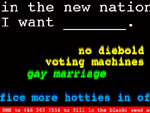
The Screensavers
At the NewNation Party in DUMBO Brooklyn, NY a few weeks ago, a collaborative group of NYC artists known as Screensavers produced a live SMS-interactive video projection. Their projection posed questions to the party guests as they lined up to enter the venue, such as "In the NewNation I want ____", or "I would ____ for _____ in the NewNation." At the bottom of the projected image was a call to fill in the blanks by sending a cell phone text message to a particular phone number. Submitted text messages would appear in the projection, and scroll as new messages were received. The projection lasted a few hours, and was located in front of the event in DUMBO where 100-200 people waited in line to enter the venue. There were approximately 2000 total attendees, and the projection steadily received an incoming stream of messages. (more)
Posted by newradio at 11:22 AM | Comments (0)
August 04, 2004
After the Crash

RICHAIR2030
RICHAIR2030 by TAKE2030 is a fictional wireless performance set in year 2030. RICHAIR2030 incorporates ideas of the freenetwork movement developed worldwide in the early 21st century and proposes shared public consumption of wireless bandwidth in an "After the Net", "After the Crash" scenario.
It is the year 2030. The great wireless hope that promises mobility and connectivity has bubbled. The GPS satellite signals have lost track of its urbanites when cutting through the Ozone layers. The ocean-apart digital divide has sabotaged the Net. What remains of the feeble bandwidth is held and safeguarded by the wireless freenetworkers, whose self-organized and decentralized network maintains its data cloud in local communal mesh-settings. The mobile generation is grounded. The tribal gathering around freenetwork nodes is the only game in town, bringing together the signal-seeking Desparati. The self-appointed renegade roller girls, acting as the Transmitenti of free bandwidth, travel city limits in auto-powered modules. Equipped with homemade lunchbox chiputers, the roller girls pump the remaining wireless signal strength in RGB codes and sonic extravaganzas. RICHAIR2030 mobilizes roaming nodes and calls for trans-national virtual mesh network.
RICHAIR2030 works with London freenetworkers and pays tribute to the world wide wireless freenetwork movement.
RICHAIR2030 team has developed 3 chiputer (compact computer with single chip motherboard) lunchboxes that draw parallels and refers to the techno DIY culture characteristic to the UK media scene at the turn of this century. The software system is based on free BSD, linux and mesh AP applications that allow automated reboots, wireless roaming, and data push at chosen locations. The interface programming further translates raw data into visual and sonic applications. In its compact lunchbox a 256 MB flashcard holds all the data.
RICHAIR2030 is developed by TAKE2030 brave new media society that sets up and manages multiple research+development+action media-working units. TAKE2030 designates its media practices in Commons societies and proposes its strategic programme development till year 2030. Take2030: Ilze Black, Alexie Blinov, Shu Lea Cheang, Chia-liang Kao, Paul Khera, Gio D'angelo in collaboration with East London community network and sonic artists: Supermoden and 1010.org.
RichAir2030 is currently touring the UK. Next performance: August 15, 2004, Bow Arts Festival, London
Posted by newradio at 12:16 PM | Comments (0)
August 03, 2004
Painting the Street
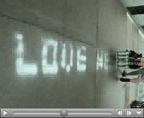
Bikes Against Bush
From "Bike Writer Pedals for Protests" by Leander Kahney, Wired News, August 2, 2004
New Yorker Joshua Kinberg is a bike messenger of a different stripe. Instead of ferrying legal papers between lawyers, he uses a homemade, wireless, bicycle-mounted dot-matrix printer to spray protest messages in the street...[Bikes Against Bush is] "painting on the street, but on the Net, too," said Kinberg, a post-graduate student at Parsons School of Design.
Continue reading at Wired.com
Posted by jo at 10:37 AM | Comments (1)
August 02, 2004
Mesh Performance Practices
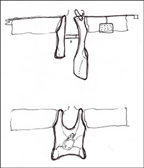
Exiles, Ghosts and Astronauts Physical interventions in the critique of virtual culture
Aura: Film Studies Journal, Volume IV, Issue 1, 1998, Susan Kozel
Exiles, Ghosts and Astronauts was a performance experiment occurring simultaneously between Riverside Studios and The Place Theatre in London (England). The videoconference link was made by Macintosh computers and basic internet videoconferencing software (CU-SeeMe). Performers in each location were projected into the other for a physical exploration of intimacy, weightlessness and altered materiality. It was part of Digital Dancing 1997, the London Dance Umbrella platform for dance and technology collaboration.
As physical exploration is undertaken, with telepresence and other forms of digital intervention in performance, the physical and philosophical vocabularies that emerge are mutually shaped and critical of one another. This article charts a course through philosophical debate and performance practice. Many voices and perspectives unfold across three sections: dialogue with Paul Virilio, devising process, and performance.
Continue reading at Mesh Performance Practices
whisper is a real-time interactive media installation based on small wearable devices, wireless computer communication, and handheld technologies embedded in evocative and playful garments worn by the participants. whisper intervenes aesthetically and critically in the evolution of our human environment by transforming the physical practices and technological interfaces that mediate our physical and emotional interchange. whisper is about creating new physical, technological, kinesthetic & affective vocabularies. whisper is a collaborative project involving artists (dance, sculpture, music), designers (of visuals, objects & textiles), computer scientists, and hardware/software engineers.
Posted by jo at 03:14 PM | Comments (0)
iSee Wireless

iSee Wireless
We are in the midst of two wireless revolutions, one defined by large corporations that buy spectrum, the other defined by ad hoc networks and open standards. We are focused on contributing to this second, more democratic revolution.
Julian Bleecker (Art Cache Machine, WiJacker, Proximity Wireless projects utilizing WiFi Toolkit software.) explores practical and playful uses of WiFi through a series of projects created with the WiFi Toolkit, a set of software APIs Bleecker developed as Engineer in Residence at Eyebeam. Art Cache Machine, the WiJacker and Proximity are three WiFi-enabled applications developed to investigate the possibilities of "partially connected" WiFi social networks using access points deliberately off the public internet. Art Cache Machine is a mobile WiFi node that provides an access point for specific digital art that can only exist within the locale of the Machine's WiFi node. WiJacker assumes the role of a WiFi node by hijacking the activity of users. Proximity is an ad-hoc communication service that enables connections between devices without user intervention.
iSee is a web-based application charting the locations of closed-circuit television (CCTV) surveillance cameras in urban environments. With iSee, users can find routes that avoid these cameras -
Who should use iSee
The past several years has seen a dramatic increase in CCTV surveillance of public space. Video cameras peer at us from the sides of buildings, from ATM machines, from traffic lights, capturing our every move for observation by police officers and private security guards that often act with very little public or legislative oversight. While the effectiveness of these devices in reducing crime is dubious at best (see below), recent cases of misuse by public and private authorities serve to question the appropriateness of video monitoring in public space. Here is a short list of people who might legitimately want to avoid having their picture taken by unseen observers:
Minorities
One of the big problems with video surveillance is the tendency of police officers and security guards to single out particular people to monitor. It is hardly surprising that the mentality leading to racial profiling in traffic stops has found similar expression in police officers focusing their cameras on people of color. Indeed, a recent study of video surveillance in the UK, the leading user of CCTV surveillance systems, says that "black people were between one-and-a-half and two-and-a-half times more likely to be surveilled than one would expect from their presence in the population." It is worth pointing out that, in this study, 40% of people that the police targeted were picked out "for no obvious reason," other than their ethnicity or apparent membership in various subcultural groups. In other words, they were singled out not for what they were doing, but simply based on how they looked.
Women
It appears that police monitors just can’t seem to keep it in their pants when it comes to video surveillance. In a Hull University study, 1 out of 10 women were targeted for “voyeuristic” reasons by male camera operators, and a Brooklyn police sergeant blew the whistle on several of her colleagues in 1998 for “taking pictures of civilian women in the area ... from breast shots to the backside."
Youth
Young men, particularly young black men, are routinely singled out by police operators for increased scrutiny. This is particularly true if they appear to belong to subcultural groups that authority figures find suspicious or threatening. Do you wear baggy pants or shave your head? Smile – you’re on candid camera!
"Outsiders"
The Hull University study also found a tendency of CCTV operators to focus on people whose appearance or activities marked them as being "out of place." This includes people loitering outside of shops, or homeless people panhandling. Not surprisingly, this group includes individuals observed to be expressing their opposition to the CCTV cameras.
Activists
Experience has shown that CCTV systems may be used to spy on activist groups engaged in legal forms of dissent or discussion. Indeed, the City College of New York was embarrassed several years ago by student activists who found, much to their dismay, that the administration had installed surveillance cameras in their meeting areas. This trend shows no signs of abating: one of the more popular demonstrations of CCTV capabilities that law enforcement officials and manufacturers like to cite is the ability to read the text of fliers that activists post on public lampposts.
Everyone else
Let’s face it – we all do things that are perfectly legal, but that we still may not want to share with the rest of the world. Kissing your lover on the street, interviewing for a new job without your current employer’s knowledge, visiting a psychiatrist – these are everyday activities that constitute our personal, private lives. While there is nothing wrong with any of them, there are perfectly good reasons why we may choose to keep them secret from coworkers, neighbors, or anyone else.
But what’s the harm?
Clearly, video surveillance of public space represents an invasion of personal privacy. But so what? Having one's picture taken from time to time seems a small price to pay for the security benefits such surveillance offers. It's not like anyone ever sees the tapes, and let's be honest
Unfortunately, this is not entirely accurate. The fact is, there is very little oversight of video surveillance systems, and the question of who owns the tapes
The fact is, many of the cameras monitoring public space are privately owned. Banks, office buildings, and department stores all routinely engage in continuous video monitoring of their facilities and of any adjacent public space. The recordings they make are privately owned, and may be stored, broadcast, or sold to other companies without permission, disclosure, or payment to the people involved.
Similarly, video footage that is captured by public police departments may be considered part of the "public record," and as such are available for the asking to individuals, companies, and government agencies. At present, there is precious little to prevent television programs like "Cops" and "America's Funniest Home Movies" from broadcasting surveillance video without ever securing permission from their subjects.
Sound far-fetched? Already in the UK
Similarly, there has been a proliferation of "spy cam" websites featuring clandestine footage of women in toilets, dressing rooms, and a variety of other locations. A lack of legislative oversight allows these sites to operate legally, but even if new laws are passed, the nature of the Internet makes prosecutions highly unlikely.
As video surveillance systems evolve and become more sophisticated, the opportunities for abuse are compounded. Sophisticated video systems can identify the faces of individuals (matching video images to databases of known faces
All of this says nothing about the societal impact of our increasing reliance on surveillance, and our growing willingness to put ourselves under the microscope of law enforcement and commercial interests. Once a cold-war caricature of Soviet-style communist regimes, the notion of the "surveillance society" is increasingly employed to describe modern urban life in such bastions of personal liberty and freedom as the United States, United Kingdom, and Canada.
While the nature of such a society has been long theorized by philosophers, critics, and sociologists, the psychological and social effects of living under constant surveillance are not yet well understood. However, the impacts that CCTV systems have on crime are beginning to be known.
Video Surveillance and Crime
Touted as a high-tech solution to social problems of crime and disorder by manufacturers selling expensive video surveillance systems to local governments and police departments, CCTV has gained much popularity in recent years. These manufactures claim that CCTV
CCTV is often promoted with thinly veiled references to the threat of terrorism: hence their widespread use in the UK, which has long lived with bomb threats and other violent actions. Already, in light of the September 11 attacks, video surveillance manufacturers have begun to court the American public
Attempting to capitalize on an international tragedy to sell product in this manner may seem tastelessly opportunistic at best. Given the track record of CCTV systems to date, this strategy seems downright cynical. According to studies of the effectiveness of video surveillance in use throughout the UK, there is no conclusive evidence that the presence of CCTV has any impact on local crime rates. While there have been examples of reduced criminality in areas where CCTV has been installed, these reductions may also be explained by other factors, including general decreases in crime throughout the UK. Indeed, in several areas where CCTV was installed, crime rates actually increased.
Given the widespread use of these systems, it is surprising how infrequently they lead to arrests. According to one report, a 22-month long surveillance of New York's Times Square led to only 10 arrests (those cameras have since been removed). Furthermore, the type of crime against which CCTV is most effective seems positively mundane when compared to its advocate's claims of stopping terrorism and kidnappings. A study of CCTV use in the UK found that the majority of arrests in which video surveillance played a significant role were to stop fistfights. Again, this was a relatively infrequent occurrence, and hardly seems to justify the price tag and loss of privacy these systems inherently engender.
More disturbing, however, was the finding that incidents of police brutality and harassment captured by CCTV surveillance were routinely ignored. The tapes of these events also had a tendency to be "lost" by operators.
The effect of video surveillance on criminal psychology is also not well understood. One Los Angeles study found that cameras in a retail store were perceived by criminals as a challenge, and in fact offered became an inducement towards shoplifting.
At best, CCTV seems to not reduce crime, but merely to divert it to other areas. According to one Boston police official, "criminals get used to the cameras and tend to move out of sight."
A final thought...
Given heightened awareness of public safety and increased demand for greater security in the face of growing threats of terrorist violence, projects that undermine systems for social control may seem to some viewers to be in poor taste. It is the Institute for Applied Autonomy's position that such times call out all the more strongly for precisely these kinds of projects. As spytech dealers stumble over themselves in their haste to auction off our civil liberties - wrapped in the stars and stripes, tied up tight with memorial ribbons - to right-wing politicos who drool and salivate in anticipation of railroading their own Orwellian wet-dreams of social control through our legislative bodies, there is a vital need for independent voices that cry out against such cynical exploitation of legitimate human fear and suffering for political power and monetary gain. The Institute for Applied Autonomy is such a voice. iSee is our statement.
- Brought to you by the Institute for Applied Autonomy "now more than ever"
Posted by michelle at 12:55 PM | Comments (0)
August 01, 2004
Mixed Reality in Los Angeles
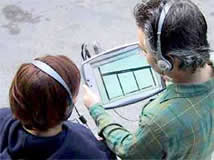
GPS Walkabout
34 North 118 West plays through a Tablet PC with Global Positioning System receiver and headphones. GPS tracks your location to determine how the story unfolds - in real time, in real space, as you traverse the sidewalks of Los Angeles.
Description of Tour: Imagine walking through the city and triggering moments in time. Imagine wandering through a space inhabited with the sonic ghosts of another era. Like ether, the air around you pulses with spirits, voices, and sounds. Streets, buildings, and hidden fragments tell a story. The setting is the Freight Depot in downtown Los Angeles. At the turn of the century Railroads were synonymous with power, speed and modernization. Telegraphs and Railroads were our first cross-country infrastructures, preceding the Internet. From the history and myth of the Railroad to the present day, sounds and voices drift in and out as you walk. Read Narrative Archaeology by Jeremy Hight.
Posted by michelle at 06:07 PM
O.U.T. There
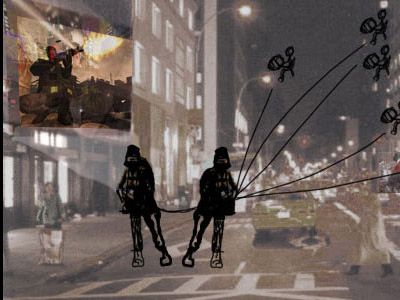
Two women in gear are on the ground. One with a laptop and the other with a projector pointing onto building walls in 3 key locations in the city. They are connected through a mobile wireless bicycle to an online team of five game players located around the world. They intervene on servers in a popular online military simulation game with performance actions carried out by the whole team. The live projections in the city can also be viewed through a web cam on the OUT website.
OUT takes its name from MOUT a military term for Military Operations in Urban Terrain. Many military simulation computer games implement MOUT. For example, the US Army developed game Full Spectrum Warrior trains gamers in MOUT combat. OUT is a criticism of the increasing militarization of civilian life which has been implemented in the US and elsewhere since 911. The Patriot Act, surveillance of public libraries, and the increased powers of government to hold citizens in military custody without trial are instances of these increased powers of government instigated by the Bush administration. In an endless spiral war of terror a government is at war with its own citizens, with soldiers in the midst of the fabric of ordinary life, as has been the case for a while in terror alert cities like Tel Aviv and Jerusalem.
OUT is an artistic intervention in the public space of online games and cities. OUT is also happening at a moment when the street has become again a viable mode of expression. From Seattle to Cancun activists are using wireless technologies and the web to organize actions and and congregate. Dada-like agenda-less mobs have appeared in New York and spread to other cities, In contrast, police at these events are increasingly high tech and cyborgean. They wear the latest riot gear shields and padding and use high tech wireless communication systems. They move in sophisticated crowd control formations. OUT, on the other hand, is a high tech art intervention, art activists with high tech gear and strategy. OUT of the closet of MOUT.
Republicans OUT of New York. The United States OUT of Iraq and the Middle East. Escalating worldwide Militarism and Violence, from whatever source, (right wing oil hungry U.S. capitalists or wealthy Islamic fundamentalists), OUT of Civilian Life. The U.S. Army and Pentagon computer game developers OUT of the minds of prebuscent gamers.
Posted by michelle at 03:45 PM | Comments (0)
July 31, 2004
Mobile Culture-Scratching
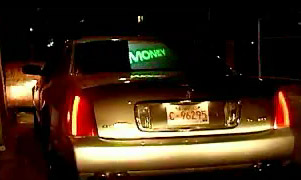
by Julie Andreyev, at New Forms Festival 2003, consists of 3 cars fitted with video projection on the rear windshield. Each car has a theme determined by the character of the car, and by characteristics of the host city where the fleet is mobilized. The choice of cars for the project reflects the specific car culture of the host city expressed through customization and branding.
Mobile Equipment
The cars are set up with equipment to allow for mobile video downloading, and video mixing using data from the car. While the fleet is mobile, videographers in the downtown site are creating videos for projection on the cars. The themes are used as a guide for them to create footage of the activities of a city's inhabitants.
Networked Process
This footage is uploaded by the videographers onto a web server. Then, the footage is downloaded by the cars as they drive by WIFI (wireless internet) download sites. A sound artist records ambient sound using a microphone held outside the window of one of the cars, mixes this, and plays it back using an FM transmitter. Nearby cars can tune into our frequency and hear the audio sampling. Each car is equipped with a sensor and software patch that interprets data from the car.
Software Interface
For example, one sensor reads data from the engine speed. This data causes a kind of 'jittery' effect to be applied to the video. The faster the car revs, the more 'jittery' the video. In this way, not only are the inhabitants of the city portrayed, but also the car is expressed in the video. After the performance, the cars can be driven into a gallery space where they can be set up to project their archive of the evenings' videos.
Mobile Portrait of the City
The goal of this project is to create a mobile portrait of the city through video and audio sampling of real time events. VJ-Fleet relies on current VJ (or video jockey) culture and the hosting city's local car and social culture. For each performance the project is customized and scaled to reflect the particular nature of the host city.
Posted by michelle at 06:37 PM
From Hactivism to Tactical Media
Hacktivism (electronic resistence within the network) has fed into tactical media: urban, mobile performance events.
Being 'wired' has become mobile, ubiquitous, sentient, pervasive, OMNICIENT monitored, computing. As we desire our movies and games to be more realistic - hyper-realistic - we now inhabit our computer-mediated, if not computer-generated worlds. We interact through joysticks that exert pressure to our response. We track oursleves with GPS-equipped devices, we pass and receive data streams: enveloped, engaged, connected, linked.
There's a surge in public events - happenings - Kaprow's "Environmental Theatre" of the collective, enabled by wi-fi technology and taken to the streets: MOBILized.
From: The ABC of Tactical Media by David Garcia and Geert Lovink
Tactical Media
"In fact we introduced the term tactical to disrupt and take us beyond the rigid dichotomies that have restricted thinking in this area for so long: dichotomies such as amateur vs professional, alternative vs mainstream. Even private vs public. Our hybrid forms are always provisional. What counts are the temporary connections you are able to make. Here and now, not some vaporware promised for the future. But what we can do on the spot with the media we have access to. Here in Amsterdam we have access to local TV, digital cities and fortresses of new and old media. In other places they might have theater, street demonstrations, experimental film, literature, photography. Tactical media’s mobility connects it to a wider movement of migrant culture."
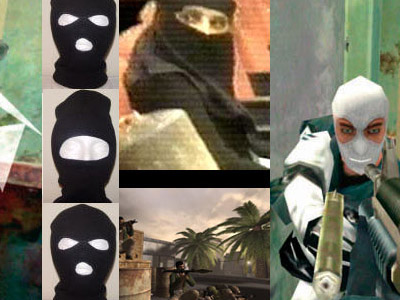 O.U.T.: Operation Urban Terrain :a live action wireless gaming urban intervention
O.U.T.: Operation Urban Terrain :a live action wireless gaming urban intervention
When: August 30, during the Republican National Convention, New York City.
Two women in gear are on the ground. One with a laptop and the other with a projector pointing onto building walls in 3 key locations in the city. They are connected through a mobile wireless bicycle to an online team of five game players located around the world. They intervene on servers in a popular online military simulation game with performance actions carried out by the whole team.The live projections in the city can also be viewed through a web cam on the OUT website.
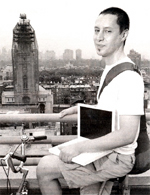 Magicbike is a mobile WiFi (wireless Internet) hotspot that gives free Internet connectivity wherever its ridden or parked. By turning a common bicycle into a wireless hotspot, Magicbike explores new delivery and use strategies for wireless networks and modern-day urbanites. Wireless bicycles disappear into the urban fabric and bring Internet to yet unserved spaces and communities. Mixing public art with techno-activism, Magicbikes are perfect for setting up adhoc Internet connectivity for art and culture events, emergency access, public demonstrations, and communities on the struggling end of the digital-divide.
Magicbike is a mobile WiFi (wireless Internet) hotspot that gives free Internet connectivity wherever its ridden or parked. By turning a common bicycle into a wireless hotspot, Magicbike explores new delivery and use strategies for wireless networks and modern-day urbanites. Wireless bicycles disappear into the urban fabric and bring Internet to yet unserved spaces and communities. Mixing public art with techno-activism, Magicbikes are perfect for setting up adhoc Internet connectivity for art and culture events, emergency access, public demonstrations, and communities on the struggling end of the digital-divide.
Posted by michelle at 01:51 PM | Comments (1)
July 30, 2004
Distributed Cinema
SPEC-FLIC
Described by Adriene Jenick as a "Speculative Distributed Cinema Project....a series of fictional events performed as distributed cinema. SPEC-FLIC is a platform for speculation, creative experimentation and imagination among UCSD students, faculty, staff and the larger public. SPEC-FLIC's title refers to speculative fiction (an area of science fiction that is focused less on new science/tech and more on societal impacts) as well as to the size (a "speck") of the PDA-based video frame that serves as the conduit for this durational collective performance. Originally described as a distributed science fiction soap opera in three phases."
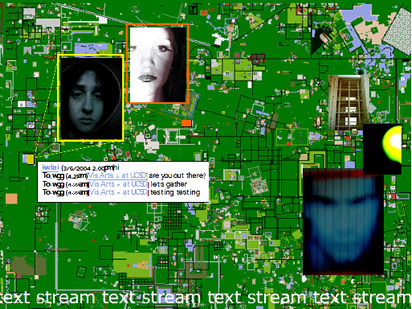
Adriene, tell us about this image.
What is the technology and experience behind this work?
Would you speak about the progression of your work from Paper Tiger television to Desktop Theatre on the internet to Active Campus and Spec Flic on the wireless network?
In your initial post you note these ongoing issues. Can you discuss them by way of examples from your work?
- timing/pacing/duration
this can be thought of from the perspective of participants or from "viewers" - in my experience the "lags" and glitches are all absorbable within the context of a live event. The archiving of this work does not allow for its tension to exist
- relationship of writing to performing, or textuality and orality
this is hugely fascinating to me especially considering the constant evolution of written and spoken language
- use of agitprop to catalyze unexpected engagements
all of my work is engaged within the larger "publc sphere" and cedes a large amount of control to the folks who are engaging with it.
Regarding SPEC-FLIC, your blog shows you in the midst of testing equipment. What are you testing? What is your creative process for working with technology and networks?
Posted by michelle at 09:42 PM | Comments (0)
Networked Local Performances
Three Performances: 2001-03: A Comment
The three location-specific performances Dialtones: A Telesymphony, Flip Flop, and Texterritory --you had to be there to experience them--introduced in the last posts were produced between 2001 and 2003 They made use of networked technologies--mobile phones, video/audio relayed by wireless broadband--to involve their audiences in the creation of the performances. Each has done this successfully in its own way, while maintaining control, in the case of Dialtones, a tight control, over the performance itself.
Posted by newradio at 10:06 AM | Comments (0)
July 29, 2004
Networked Local Performance
Dialtones: A Telesymphony
Dialtones, as described on Golan Levin’s web site, "is a large-scale concert performance whose sounds are wholly produced through the carefully choreographed dialing and ringing of the audience's mobile phones. Because the exact location and tone of each participant's mobile phone can be known in advance, Dialtones affords a diverse range of unprecedented sonic phenomena and musically interesting structures."
Preparatory to the concert, members of the audience register their wireless telephone numbers at secure Web kiosks located in the performance space. In exchange for this information, they then receive seating assignment tickets for the concert venue. New "ringtones" are then automatically downloaded to their handsets. During the concert, a small group of musicians perform the phones en masse by dialing them up with a specially designed, visual-musical software instrument. "Because the audience's positions and sounds are known to the Dialtones computer system, the performers can create spatially-distributed melodies and chords, as well as novel textural phenomena like waves of polyphony which cascade across the crowd; these musical structures, moreover, are visualized by a large projection system connected to the performers' interfaces. Towards the end of its half-hour composition, Dialtones builds to a remarkable crescendo in which nearly two hundred mobile phones peal simultaneously."
Posted by newradio at 06:26 PM
Networked Local Performance
Flip Flop
Flip Flop comprises a group of motion poets, cyborgs, and sound, video and net-artists who collaborate on ‘site-specific remote connection theater performances’ that, in their words, "challenge boundaries between audience and performer, on-stage and off-stage, the venue and the street outside."
For instance: the audience is invited to a party where, over the course of the evening, one of the partygoers (actor and motion poet Ajay Naidu) emerges as a performer, and the audience gradually realizes that it is participating in theater. As the performer shifts between private conversation and "narrative outbursts," the event shifts in mood and form.
Simultaneously, a performer, equipped with a wearable multimedia-streaming computer roams the neighbourhood. The route is choreographed to synchronise with the performers story, and a live "point-of-view" video feed (as well as audio) from the wanderer is relayed by wireless broadband to the performance venue. Flip Flop was performed in July, 2002. Read a report on Live Streaming as Dramaturgy.
Posted by newradio at 06:17 PM
July 27, 2004
More about Blast Theory
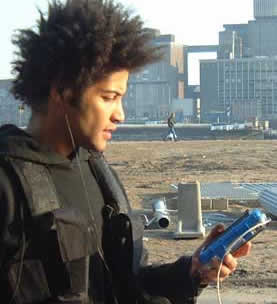 Matt Adams of Blast Theory posted a comment of encouragement to the blog's opening and I'd like to follow up with more about Blast Theory and a call out to Matt to respond to some specific questions about their work.
Matt Adams of Blast Theory posted a comment of encouragement to the blog's opening and I'd like to follow up with more about Blast Theory and a call out to Matt to respond to some specific questions about their work.
Blast Theory, comprised of Matt Adams, Ju Row Farr, and Nichols Tandavanitj, describe themselves as 'an artist group whose work explores interactivity and the relationship between real and virtual space with a particular focus on the social and political aspects of technology. It confronts a media saturated world in which popular culture rules, using video, computers, performance, installation, mobile and online technologies to ask questions about the ideologies present in the information that envelops us.'
This is evident in a survey of their work over the past decade. Formed in 1991, a chronology of their work from 1994-2004 is available on their website where the themes and explorations of technology range from video in live performance to interactive installations with the most recent using a pda or 3G phone to enable a mixed-reality game-based experience.
Beginning with their 1999 work Desert Rain and continuing on to the mixed reality works Can You see Me Now (project website), Uncle Roy All Around You (project website), and I Like Frank (project website) they have collaborated with the Mixed Reality Lab (MRL), an interdisciplinary research initiative at the University of Nottingham which brings together leading researchers in Computer Science, Engineering and Psychology to research new technologies that merge the physical and digital worlds, focusing on playful, artistic and educational applications.
The projects with MRL are clearly interactive in their game structures and use of mobile, networked technologies. The hybrid online/live action approach was explored in Kidnapped (1998) and interactivity has been a component in the early work since Stampede, (1994) in which the audience triggered how the piece unfolded via pressure pads.
Their work has been described as 'somewhere between theatre, performance art, installation and club culture' by Lois Keidan, Director of Live Arts, Institute of Contemporary Arts, London. In reviews of Uncle Roy in 2003 a direct link to the content and approach of their work can be found - a group of friends with various creative backgrounds get together to form a theater company. This comes through in Matt's initial comment to the blog in which he claims his excitement for recent developments in networked_performance, despite the backward looking stance of many traditionally moored theater and dance practitioners. Blast Theory is freed from any prior history in a single discipline by having a group comprised from various practices across which they draw to create their work.
Some Questions
Matt, firstly, correct any inaccuracies in the above. Would you tell us what are the backgrounds of the members and elaborate on the evolution of the group from the early years till now. What led to the formation of the group and why theater? It seems that BT has always had an interest in media and technology born of club culture perhaps. What is the importance of the 'live' and 'performance' aspects of your work? As opposed to addressing the same social and political themes about technolgical impact on culture by focusing solely on interactive installations, such as in An Explicit Volume, for example.
How did the collaboration with Steve Benford and MRL evolve? How has the relationship with MRL influenced BT's work conceptually? You might also elaborate on how the collaboration has enabled your work to evolve technologically as well. Can you speak about the offshoot of the BT / MLR collaborative endeavor, EVERPRESENCE and your project Vicinity to which you've been able to apply these joint efforts? It appears to include aspects of the mixed reality game-based works and a reality-tv episodic, perhaps. What's the timeline for presenting this work?
You also mentioned in your post that there is lots of interesting work happening in networked_performance. What's out there that you currently find interesting and why?...
Posted by michelle at 08:13 PM | Comments (3)
July 26, 2004
A PDA walkabout in Joyce's Dublin
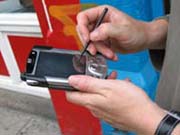
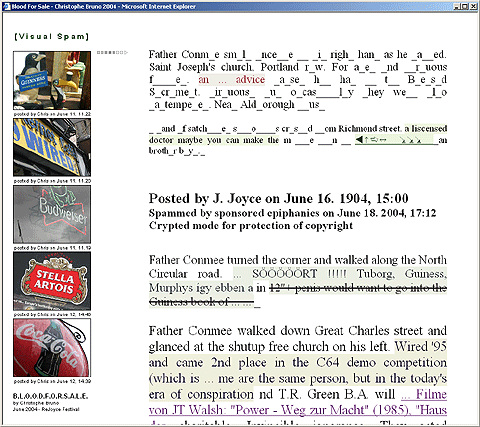
The program allows these "sponsored epiphanies" to disturb and transform the text of Ulysses, "Wandering Rocks", by incorporating themselves into the text. The real-time evolution of the text is displayed and graphically animated, sentence by sentence, projected in different places in Dublin, and online. By the end of the performance, carried out over several days, the original text by Joyce is almost entirely replaced by the "sponsored epiphanies."
Posted by michelle at 06:26 PM | Comments (0)
